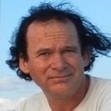Stephen Ladd's Blog
February 24, 2022
The Book is Done!
Hey you 28 followers, still following? You haven’t gotten a post from us since the voyage ended seven years ago. Time flies when you’re having kids (we now have two) and writing a book.
A new edition of Three Years in a 12-Foot Boat can now be ordered in ebook or paperback!

 Likewise Ginny’s and my book, The Five-Year Voyage: Exploring Latin American Coasts and Rivers, can now be ordered in both formats! In both cases the publication date is April 5, so you may have to pre-order with delivery on that date. The two can be bought as a series:
The Ladd Small-Boat Adventures
.
Likewise Ginny’s and my book, The Five-Year Voyage: Exploring Latin American Coasts and Rivers, can now be ordered in both formats! In both cases the publication date is April 5, so you may have to pre-order with delivery on that date. The two can be bought as a series:
The Ladd Small-Boat Adventures
.I'm sorry we never got to know most of you. If you would, please comment something about yourselves. Have you had adventures of your own you care to mention? Would you recommend other true adventure books to us?
Steve and Ginny
Published on February 24, 2022 19:41
December 19, 2014
Death of a Voyage
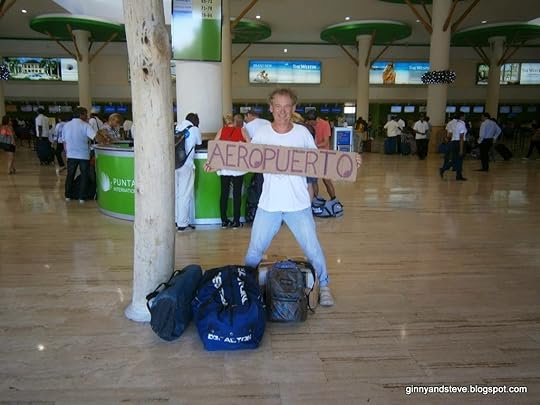
Dear friends and family,
Steve speaking. I last wrote to you from St. Martin at the northwest end of the chain of small islands that begins with Grenada. I was there for two weeks under a bridge, mainly fixing a broken mast step.
At midnight on November 19 I sailed from St. Martin for the Virgin Islands, course 300º. As clouds flew west, windows of open sky flew with them, framing ever-changing patches of stars. Thurston’s compass is unlit, and I didn’t want to ruin my night vision by keeping my headlamp lit, so I kept finding new stars to steer by, each with a different reference point on the boat, like the motor’s gas cap or the starboard oarlock. I changed star and reference point every ten minutes or so. The lights of St. Martin and Anguilla dulled and faded astern as the night progressed. The wind blew inconstantly between ten and twenty knots.
In the morning a series of rains passed over. But these rains were not the squalls that had pummelled me in the Guyanas. The wind picked up and died only marginally as they passed over. In a day alone at sea I saw only one cruise ship, like a white ghost stalking the world’s northern rim. The air was cool and damp. No longer in the tropics, I wore rain pants and a windbreaker. I frequently glanced aft. The coming waves were 6-8 feet tall, worth keeping track of. To stay awake I drank a 1.5-liter bottle of cola.
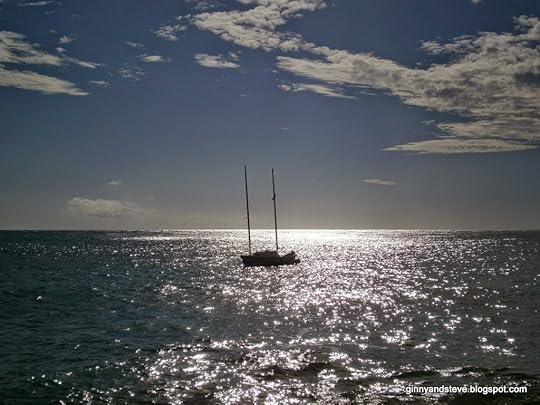
Virgin Gorda (Fat Virgin) is well-named because she is bulky, smooth, and nicely rounded. Haze hid her until only sixteen miles away, but this delayed sighting was less traumatic than in pre-GPS 1993, when I almost missed the British Virgin Islands altogether! I sailed around Virgin Gorda’s north end and slept at anchor in a bay full of chartered sailboats.
Sparkling white sails flitted here and there as I cruised down Sir Francis Drake Channel, spending nights in Tortola, St. Thomas, and Culebra. As always, in towns where waterfront is expensive and there is no public landing, I looked for a place where I could step ashore without the property owner objecting, yet that was public enough that a potential thief would fear being seen. It was usually in a quiet corner that developers hadn’t touched lately, within a few paces of a public road. This scouting is much like when we are on the road and looking for a place to sleep in our vehicle. It requires consideration of both physical characteristics and the likely reaction of unknown people.

As I continued around the south coast of Puerto Rico the water was brilliant blue where deep, jade green over shallows. I reefed so as to only occasionally surf wave fronts and maintain an average speed of around 5.5 knots. Going faster was too stressful. Ponce is the principal city on Puerto Rico’s beautiful south coast. As in 1993 I asked the Ponce Yacht Club management if I could anchor off their beach and access town through their gate. This time they weren’t as enthusiastic, but when I showed them the pages in Three Years in a 12-Foot Boat that describe my previous warm welcome they honored that precedent! As in 1993 I walked a lot because the stores are miles inland, and found white gas at the same Kmart. This was a great relief after using automotive gas in our stove for three years. An American in Puerto Rico feels comfortable because the people know the States well; you aren’t entirely a foreigner to them.
From Boquerón, at Puerto Rico’s southwest corner, I sailed halfway across the Mona Passage to Isla Mona, which stands by itself, five miles in diameter. In 1993 I didn’t linger because a cold front was due to arrive. This time I stayed a second night. It is a nature reserve, with only a small staff and sportsmen that come to hunt the goats and wild pigs that impact the native sea turtles and the Mona iguana, which exists no where else in the world. I hiked all day on trails etched through the cactus and-small-leaf scrub. The island is a plateau surrounded by cliffs, made of karst: crackling limestone full of caves and sinkholes. Only at the end of the day, my feet satisfactorily blistered, did a ranger tell me I wasn’t allowed there because I didn’t have a permit.

The second half of the Mona Passage concerned me more than the first half. For one thing I couldn’t leave at night because in order to maximize my protection I had worked my way in among some coral heads before anchoring, and I was afraid I might bump into them in the dark. For another, whereas in 1993 I sailed around the south side of Hispaniola (the island shared by the Dominican Republic and Haiti), this time I wanted to go north-around in order to position myself for the Turks and Caicos, which would in turn position me for the Bahamas. The east coast of the Dominican Republic consists of capes projecting eastward into the wind, useless in terms of protection. The north coast also has few harbors. But, having read a cruising guide and studied the area with Google Earth, I saw places that might shelter a small, shallow-draft boat able to come in among corals and mangrove.
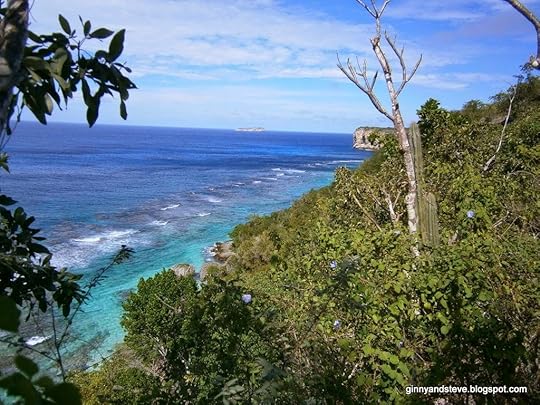 It was December 1, 2014. The sea outside Isla Mona’s lee was fierce. For only the second time during the voyage (the first time was tacking out to Mexico’s Chinchorro Bank) I left the cockpit drain open while underway because I couldn’t keep up with the bailing. (With the drain open a few gallons of water ride along in the footwell, robbing a bit of Thurston’s buoyancy, but it can’t get any worse.) I steered northwest, and in the afternoon started seeing a low coast to port. I rounded Cabo Engańo (Cape Cheat) several miles out. Here a coral reef began, paralleling the coast a mile offshore. The shallow lagoon between was exposed to wind waves but free of swell energy, it having been dissipated in huge breakers. I passed a local skiff fishing outside the reef. It was visible only when both it and I were atop waves. If either of us was in a trough it disappeared from view. The swells were about ten feet tall, but there must be a way back in or the skiff wouldn’t have come out.
It was December 1, 2014. The sea outside Isla Mona’s lee was fierce. For only the second time during the voyage (the first time was tacking out to Mexico’s Chinchorro Bank) I left the cockpit drain open while underway because I couldn’t keep up with the bailing. (With the drain open a few gallons of water ride along in the footwell, robbing a bit of Thurston’s buoyancy, but it can’t get any worse.) I steered northwest, and in the afternoon started seeing a low coast to port. I rounded Cabo Engańo (Cape Cheat) several miles out. Here a coral reef began, paralleling the coast a mile offshore. The shallow lagoon between was exposed to wind waves but free of swell energy, it having been dissipated in huge breakers. I passed a local skiff fishing outside the reef. It was visible only when both it and I were atop waves. If either of us was in a trough it disappeared from view. The swells were about ten feet tall, but there must be a way back in or the skiff wouldn’t have come out.On Google Earth I had identified a breaker-less pass a quarter mile wide with many boats anchored just inside. I arrived per the GPS. It looked clear so I reefed down, to take it slow, and steered into the gap. Everything looked good until the breakers were immediately to my left and right. Suddenly a roar caused me to look back. A breaker as big as those to either side was rearing up! No matter how I steered I would broach. One second I was saying, “Oh shit,” the next I was swirling underwater, blind and disoriented. My tether towed me until my belt and fanny pack strap, to which the clip was attached, both parted. Soon thereafter I broke surface. Thurston was back on her bottom. She had quickly self-righted because both masts were gone. Masts, booms, sails, and oars were floating just upwind. The wind was blowing Thurston toward the beach faster than the flotsam. We seemed to be past the critical line so I anchored (the anchor and rode had stayed in place under their cover at the bow) then swam this way and that recuperating Thurston’s parts as they floated by.
A Sea Pearl’s masts consist of a smaller upper aluminium tube lodged inside a larger lower tube. Both masts’ upper tubes had broken where they immerge from the lower tube. The main sail had a hole in it, the mizzen was shredded. My sliding-seat rowing station had worked loose from its holder and sank. The motor had spent time underwater, so it couldn’t be expected to start. All three of Thurston’smodes of propulsion were gone.

As I pulled the last piece of mast and sail aboard an open boat drew up. They were two Dominican Navy guys come to rescue me. I could have paddled ashore but it was easier to go along. I couldn’t pull the anchor up, it having snagged on a coral head, so I tied a buoy to its rode for later retrieval. (I subsequently returned to that spot per my GPS, which survived the capsize, but couldn’t find the buoy.) The corals, orange-ish columns in the turbid, turquoise water, rose almost to the surface. This was not a pass! The Navy guys, afraid of another breaker, quickly towed me to the anchorage, where I dropped my remaining hook.
The other boats were for the tourist trade: marlin-fishing boats, “pirate” barges, glass-bottom excursions, etc.I started putting things in order. Thurston had performed as designed. No water had entered the cabin. Her 24 tanks and bins, which ballast her, had shifted to starboard a couple inches, riding up and over the “blobs” intended to hold them laterally, but they had not come loose. The floorboards (3/16” aluminium) had bulged upward but their edges were still trapped under the port and starboard “ledges.” Judiciously hammering, I got everything back into place. Smaller objects had travelled in circumferential paths. Evidently the breaker slammed her starboard-side-down then rolled her 360º. Her mast heads may have hit bottom on the way.

The satellite photos one accesses through Google Earth are a weak guide because they capture only a point in time with no information as to swell height, tidal state, or wind condition where and when the photo was taken. These factors may be more or less conducive to breakers when you arrive. In this case they were more conducive.
I should have studied the “pass” more, cruising back and forth at a safe distance. I would have seen the occasional breakers and known I had to keep to sea that night, an unpleasant prospect but better than capsizing. Protected water is like the Sirens of Odyssey fame, luring the sailor onto the rocks. He so craves rest he succumbs to wishful thinking and relaxes his vigilance. I had capsized due to waves in Squeak a few times during my 1990-93 voyage, but never in one these bone-crushers. I had came close, and had nightmares about them, but until now could only wonder what it would be like. I lost the rig only because I was sailing at the time. If I had rolled up the sails and motored in the masts would not have broken (but the motor might have ingested more water).
I was angry at myself. To fix Thurston would cost plenty and further delay my reunion with Ginny and George. Thurstonwas old and of little market value, so she could be considered totalled. We planned to sell her when I got back anyway because she is too small now. Better to sell her for whatever I could get.I felt relief that I might soon be back with my family, and that I could say adios to this difficult coast. But I paled at the thought of not finishing the voyage, and of leaving Thurston behind after the thousands of hours of work we had put into her.
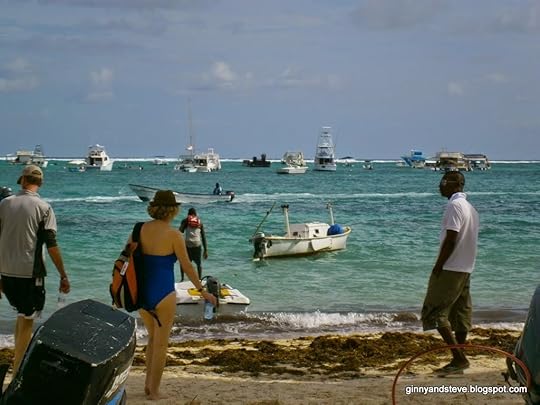 The anchorage was rough, but I had to stay put for a day and a half until officials cleared me in. Then I anchored closer and swam ashore. I walked in both directions looking for things lost in the capsize, like my cockpit cushion and water bottle, but too much time had passed. Dozens of swarthy men in jump-suits were clearing seaweed off the beach. This coast is a huge tourism complex! They call it Punta Cana after a minor point whose name has a better connotation than Cabo Engańo. For twelve miles the beautiful beach is strung with fine hotels. Millions of vacationers visit annually from all over the world.
The anchorage was rough, but I had to stay put for a day and a half until officials cleared me in. Then I anchored closer and swam ashore. I walked in both directions looking for things lost in the capsize, like my cockpit cushion and water bottle, but too much time had passed. Dozens of swarthy men in jump-suits were clearing seaweed off the beach. This coast is a huge tourism complex! They call it Punta Cana after a minor point whose name has a better connotation than Cabo Engańo. For twelve miles the beautiful beach is strung with fine hotels. Millions of vacationers visit annually from all over the world.My immediate beach supported a large community of Dominican and Haitian tourism laborers. They were excursion organizers, gift shop hawkers, and masseuses. One guy trained manta rays at a nearby aquarium. Another took people up in a flying boat. All day long they said, “Hello my friend!” to the people passing by in swim suits and tried to herd them this way or that. Inland there was no town in the conventional sense, just scattered commercial strips and malls.
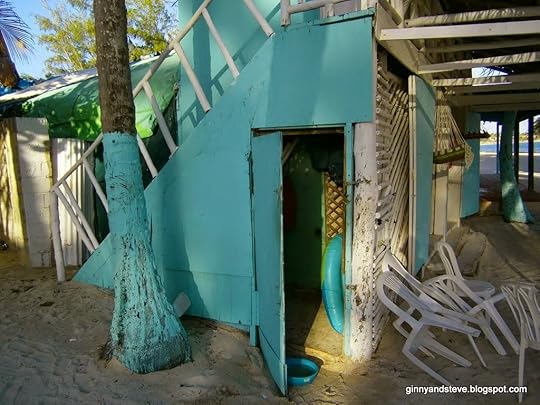 Word of my plight got around. A mechanic fixed my motor for free. The clerk at a pharmacy gave me free wi-fi. The landlady for several shops gave me a space under a stairway to put my stuff and sleep. It was close to Thurston so I could keep an eye on her. When the space became full of my stuff I slept upstairs on a massage table or in my tent on the sand.
Word of my plight got around. A mechanic fixed my motor for free. The clerk at a pharmacy gave me free wi-fi. The landlady for several shops gave me a space under a stairway to put my stuff and sleep. It was close to Thurston so I could keep an eye on her. When the space became full of my stuff I slept upstairs on a massage table or in my tent on the sand.I let it be known that Thurston was for sale for $1000. A fishing-charter crewmember known as Tio (Uncle) immediately wanted her. Tio was of mixed African and Hindu blood, barrel-chested, with greying hair tied tightly into a bun on the top of his head. His posture was erect, his face sharp, almost fierce. He got along well with everyone yet kept aloof. Having lived in Brooklyn he spoke English, often finishing a statement with the words, “You know what I’m a-sayin’?”. Dedicated to his work and family, he also laughed a lot and appreciated a good adventure. He wanted to restore Thurston and not change a thing. He would use her personally, not as a tourism venture.
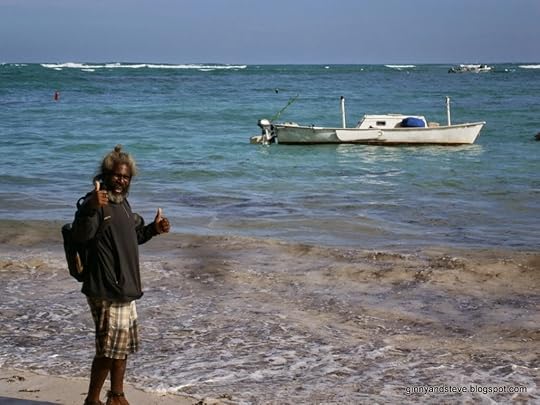
It took a week for papers to be drawn up and for Tio to get the majority of the money together. The lawyer will give him the title when he wires me the rest. Meanwhile a Naval Intelligence agent smelling strongly of corruption periodically reminded me that I must report to him before I left the country. His organization had already extracted money for the privilege of searching Thurston for drugs, and they wanted another crack at me after I had received payment for the boat. Tio and I thwarted him by keeping it a secret. I bought a ticket on-line and in the coming days pretended to not know when I would be leaving. The locals were friendly but too inquisitive.
During five years we had accumulated a lot of stuff considering how small Thurstonis. I decided what to keep and how to ship it. On my last swim out to Thurston I cried and patted her affectionately. “You’re a f**kinggood boat,” I said, “A f**king good boat!” And so she is. What other vessel could have taken us all those places? Her every detail was honed to perfection in the rough-and-tumble of ultra-light voyage.On December 14, 2014, almost exactly five years after we departed from Pine Island, Florida I stepped off a plane at Sea-Tac airport and hugged my family. George grinning wide in disbelief. The next day I went to Goodwill, bought a belt, and threw away the rope I’d been using to hold my pants up. I am no longer a shipwrecked sailor.
Steve LaddFor more photos see https://picasaweb.google.com/ginnygoon/VirginIslandsToDominicanRepublicAndHome
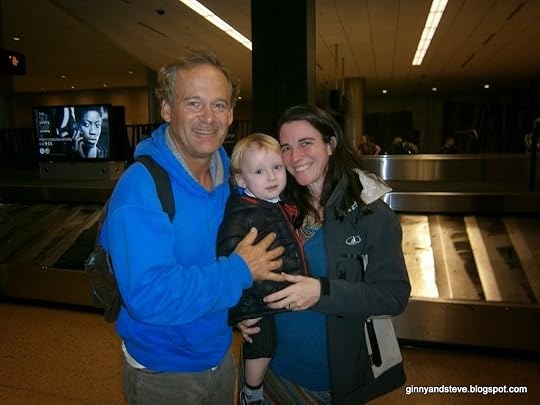
Published on December 19, 2014 10:19
November 27, 2014
Sint Maarten, West Indies - Mass Email

Dear friends and family,
Steve speaking. I last wrote to you from Trinidad, southernmost of the Caribbean island chain. I was there for three weeks at a marina, fixing things, writing, and mapping.
On October 13, my work finished, I launched Thurston, cleared customs, and motored west around the mountain range that caps the island’s north end and extends west as a peninsula, not quite reaching Venezuela. Passing through the Dragon’s Mouth, northern gate to the Gulf of Paria, Thurstonre-entered the Caribbean after an absence of three years. My first passage would be to Grenada, eighty miles north. The wind and current would be carrying me west, so I travelled east along Trinidad’s north coast twenty miles to better situate myself for the jump-off. To minimize my exposure to the contrary Guyana Current, wherein sufficient water enters the Caribbean to match that which exits it via the Gulf Stream, I followed the cliffs closely and dipped into amphitheatre bays. Cactus and palm trees grew on rocky shelves. At one headland, following the example of a fishing skiff, I cut through a gap between the mainland and a craggy island taller than it was long or wide. The vertical walls of this marine alley were ten paces apart. A heavy ground swell was running through the gap, occasionally breaking white against the walls. The swells reeled, tipped, and rolled through the chasm. I stayed in the center, not to be dashed against a wall. It reminded me of a carnival ride I went on as a child where you walk down a long, revolving tube.
I reached Maracas Bay after dark, anchored in its most protected corner, and rested a bit. Then at midnight I turned on my navigation lights and steered north toward Grenada, the motor at half throttle. There was no wind. A half moon illuminated sea and clouds. Heat lightning played in the sky ahead. Later enough breeze stirred to allow some sailing, but not enough to turn the motor off. The sun came up and I fought sleep. In 1992 I got a ride across this strait with Squeakaboard a freighter. This time, with a motor, I did it on my own.
At 4:00 I entered Prickly Bay on the south coast of Grenada. Hundreds of yachts were moored there because it was hurricane season and Grenada, like Trinidad, lays south of Hurricane Alley. I found wi-fi ashore and told Ginny I was OK, then anchored in shallow water off a swimming beach. A sign said No Anchoring, but I got away with it.
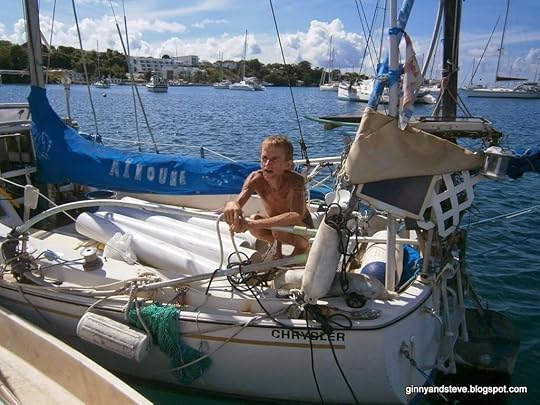
In the morning I visited with a wraith-like French Canadian live-aboard I had met the evening before. He sold art to support himself, but had only earned $30 in the past three months! He was skinny as a rail and his feet were swollen from malnutrition. I gave him some potatoes, which he ate raw because he didn’t believe in cooking food. He claimed to be learning to live without food and water altogether, based on some alternative-spirituality theory. “Then I won’t have to worry about food anymore,” he said. His boat was a worthless hodge-podge. The bottom hadn’t been scraped for ten years. He had taped and twined a framework of plastic pipes onto the bow of his dingy, like a projecting prow, and intended this evolving sculpture to become his new main boat, in a logic I couldn’t fathom. He had made it all the way down from Montreal, but what would he do now, starving, hardly able to walk, with a boat that could barely move? As I worked my way up the chain I would meet others who had followed a dream but reached dead ends.
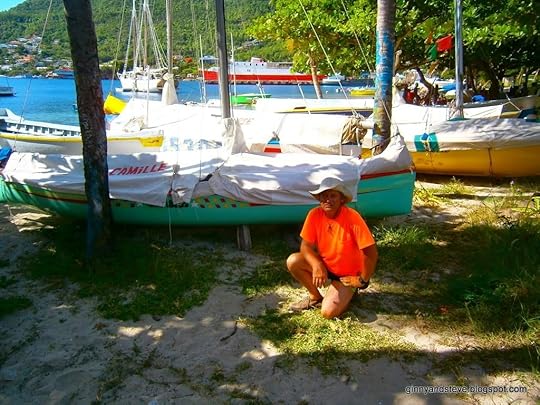 I got some East Caribbean dollars at a cash machine, and in the following days revisited islands along my 1992 route. In Bequia I ran into Andy, whom I wrote about in Three Years in a 12-Foot Boat, and swam a stretch of coast looking unsuccessfully for an underwater tunnel I found back then. I stayed only a day or two each in St. Vincent, St. Lucia, and Martinique. Everything seemed smaller and closer together than I remembered, but as beautiful as ever, so lofty and emerald green. If only Ginny and George could have been with me! But they were with in Los Angeles with Ginny’s mom, Lois, helping her get through a surgery on her pancreas.
I got some East Caribbean dollars at a cash machine, and in the following days revisited islands along my 1992 route. In Bequia I ran into Andy, whom I wrote about in Three Years in a 12-Foot Boat, and swam a stretch of coast looking unsuccessfully for an underwater tunnel I found back then. I stayed only a day or two each in St. Vincent, St. Lucia, and Martinique. Everything seemed smaller and closer together than I remembered, but as beautiful as ever, so lofty and emerald green. If only Ginny and George could have been with me! But they were with in Los Angeles with Ginny’s mom, Lois, helping her get through a surgery on her pancreas. On the west coast of Dominica I found the Layou River unchanged. As in 1992, it was just deep enough, and I and the available little boys were just strong enough, to pull my boat up a 200-yard-long natural spillway through a gravel beach to a limpid lagoon behind the impoundment. “Tie up good, the river goes strong she rain,” said a local guy whom I joined on the bank for conversation.“Did you clear in at Roseau?” asked another.I waded back out into the water. “I don’t have to clear in because I’m not on land, see?”My interrogator laughed. “Don’t worry, I am not a policeman.”
On the west coast of Dominica I found the Layou River unchanged. As in 1992, it was just deep enough, and I and the available little boys were just strong enough, to pull my boat up a 200-yard-long natural spillway through a gravel beach to a limpid lagoon behind the impoundment. “Tie up good, the river goes strong she rain,” said a local guy whom I joined on the bank for conversation.“Did you clear in at Roseau?” asked another.I waded back out into the water. “I don’t have to clear in because I’m not on land, see?”My interrogator laughed. “Don’t worry, I am not a policeman.”Hustlers hassled me in the towns of these poor islands, but here in the countryside my curious acquaintances left when they saw I was ready to retire. No one bothered me as I slept afloat in that fresh pond, nor in the morning half-light when I tied a line to Thurston’s bow and lowered her stern first through the river’s swift final rush, wading upstream of her, leaning back against her resistance, pulling left or right to steer her. Where fresh and salt water joined, in a minor confusion of conflicting waves, I got in and continued north.
Since leaving Belém I had travelled 1,570 nautical miles, averaging 18.5 miles per day including days in port. At that rate I would reach Florida in early January. The separation had not been easy for Ginny or me. She sent me lots of pictures and videos of George. He was always being cute and doing new things. I ached with saudade, as the Brazilians would say.
I constantly looked for free places to sleep in calm water and get ashore without a dinghy. Sometimes I found places to wade ashore unopposed. Other times I stuffed clothes and fanny pack into a waterproof bag and swam in from an anchorage, then changed on the beach. In Rodney Bay, St. Lucia, I thought I had hit the jackpot when I found, behind a mega-yacht marina, on a shoreline adjoining the main road, a line of cheap and abandoned boats. Those boat owners obviously weren’t paying much, so I pulled in there too. My self-congratulation waned when a black man angrily approached. “What you doing coming into my marina without permission first?” he demanded. He had built a couple of flimsy wooden platforms over the water, probably without permission, and in his mind this made him the owner of a marina, albeit on a smaller scale than the real marina. I might have contested his right to charge me except I hadn’t cleared in and needed to avoid the authorities. It didn’t make sense to legally enter island nations where I only stayed a day or two. The processes are time-consuming and they often want money now. And every island, or pair of islands like St. Kitts and Nevis, is a different country!
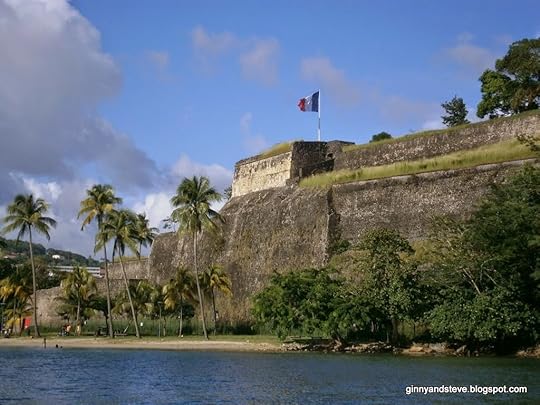
Martinique and Guadeloupe differed from the English-speaking islands in that they were part of France. White or black, the people were French, and financially secure. They used euros. The English speaking islands were more independent, and poorer.
Around Martinique the winds came back. I sailed more as I rounded the curve of islands, my northing done for now and a lot of down-wind sailing to look forward to. I tethered myself in for the crossings in case I fell overboard. My course was a succession of open crossings then a coastal run up the island’s lee. They were old volcanoes, bulky enough to shade me from waves and the harsh morning sun. At an island’s north end I passed through a zone of unpredictable gusts and wind veers before enjoying the undisturbed trade winds again.
North of Guadeloupe I left my 1992 route and went to Antigua instead of Montserrat. During the crossing one squall after another plastered me. They were areas of darker cloud mass with white or grey rain tendrils, visible well in advance but mercurial. They often dissipated before hitting, or intensified, so what looked like a flimsy shower became a big downpour forming right over me. You never know how much wind they will contain. I reefed in advance but it wasn’t enough, so I removed the main mast altogether in order to point into the wind, and kept the sea anchor tied to the bow, ready for quick deployment if all else failed. “What can go wrong?” I often asked myself, because as the wind crescendos it finds a weak link and breaks it, then a sail goes out of control. The squalls slowed me down because I could make little progress until they had passed.
At Antigua I stayed in Falmouth Harbour on the island’s south shore. It is a haven for English ex-pats that had sailed there long ago and stayed, and a focal point for high-end yacht racing, but it was the off season now. I met some fellow sailors at a yacht club bar and several times sat with them at their accustomed table. Two weeks before the eye of Hurricane Gonzalo had passed right overhead, catching everyone completely by surprise. Over a hundred boats had been lost there and at St. Barts and St. Martin. Upon my arrival the satellite weather image showed a formation identical to that which led up to the recent disaster, so everyone was prepping their boats for a repeat. I moved Thurston to the island’s best hurricane hole, English Harbour. It has been regarded as such since at least 1627, because I found a letter of that date containing that affirmation, posted in a display at the old English Harbour shipyard, which has been restored as a national park. (Horatio Nelson commanded the post for a while, so they call it Nelson’s Dockyard.) Had a hurricane hit I would have been safe, but we didn’t even get a good storm.
I sailed to St. Kitts, a sixty-mile crossing. At the capital, Basse-Terre, I found a fishermen’s harbour behind a short jetty and passed a tranquil night. The following day being Sunday no internet could be found in the old town, so I continued, past Dutch Statia and Saba, to St. Barthelemy, another French island. Gustavia, its principal town, showed sophisticated urban design in its modern yet historically sensitive architecture. A low sea-wall and esplanade encompassed the clean harbor. Boats lay tied to mooring buoys, one to bow and one to stern so no one swung, or med-moored, with one line to a buoy and another to the sea wall. The roofs were red like tiles but actually of some sheet material. Development had crept up the surrounding amphitheater of hills, but the green peaks were still sacrosanct.
I stopped at Anguilla, a British overseas territory, and used up the last of my East Caribbean dollars because they wouldn’t be any good further west. Here the expatriates in the resorts and new homes were Americans, and the development was auto-oriented with little sense of history.
On November 4 I reached St. Martin, the north half of which is French, the south half Dutch. (The Dutch spelling is Sint Maarten.) During the crossing Thurston’smizzen mast step cracked. Part of the tube the mast goes into broke off in my hand. The fitting had been leaking on-and-off throughout the voyage. Also the engine would have to be removed from the outboard again to fix a slipping clutch. These things would take a while to fix, so I cleared into the French side, where the fees are lower. Then I cruised around Simpson Bay, a large internal lagoon, looking for a good place. With no dinghy I couldn’t anchor out like the other live-aboards. While working on the mast step I couldn’t erect the awning so I needed a place with shade and shelter from the rain.

I found it under a new bridge that crosses the lagoon, by the main live-aboard anchorage. On the east end, in shallow water next to its abutment, I tied to overhead utility conduits. Then I found a heavy plank and propped it on the abutment rip-rap, weighting it with rocks so it projected toward Thurston like a diving board. Thus I could step ashore without getting my feet wet. I had to crouch under the bridge’s massive concrete beams but could stand upright between them.
I would need certain things, so I explored the highly developed area around Simpson Bay. Upon tying up at Lagoon Marina’s dinghy dock, on the Dutch side, a husky blonde man in his thirties said to the older man next to him, who turned out to be his father, “You know what this boat reminds me of? Remember that reallylittle wooden boat that stayed here a while a long time back?” “Was it around January, 1993?” I asked.“That’s about right.”“Did you have a big map on the wall back then showing hurricane tracks?”“Yes!”“That was me!” The blonde guy, Bernard, was only fourteen at the time but he remembered me. Then he was the son of the owner, a Dutchman. Now he managed the marina but his mother and father were still with him. They dug up a photo of me sailing Squeak.The marina had changed entirely, but the same family still ran it.
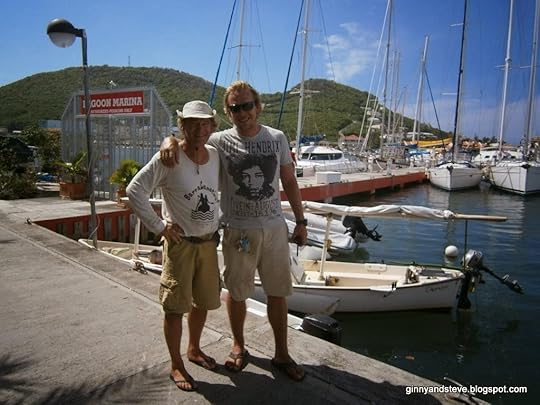 As in 1993, the boat owners were of many nationalities, the most numerous being English, French, South African, and American. St. Martin was the hardest hit in Hurricane Gonzalo. Dozens of boats lay wrecked along the shore of the Lagoon and in the saltwater bays. Little recovery had been done. No one felt responsible for disposing of the totaled boats. They will probably remain as nuisances. Many had saved their boats but sustained damage. Masts were broken off, topsides holed, stanchions bent. One live-aboard drowned. I listened to the survivors. The mayhem was fearful. The wind clocked around to the west and blew a hundred knots for three hours. Many boats dragged anchor, and many that were holding were swept away when boats dragged down on top of them. They smashed into the bridge and got their masts sheared off. Those tied to docks beat against the concrete until they sank. The wind worked the roller-furling sails loose and tore them to shreds. Some planned to fix their boats. Others lacked the money, or thought their boats weren’t worth it.
As in 1993, the boat owners were of many nationalities, the most numerous being English, French, South African, and American. St. Martin was the hardest hit in Hurricane Gonzalo. Dozens of boats lay wrecked along the shore of the Lagoon and in the saltwater bays. Little recovery had been done. No one felt responsible for disposing of the totaled boats. They will probably remain as nuisances. Many had saved their boats but sustained damage. Masts were broken off, topsides holed, stanchions bent. One live-aboard drowned. I listened to the survivors. The mayhem was fearful. The wind clocked around to the west and blew a hundred knots for three hours. Many boats dragged anchor, and many that were holding were swept away when boats dragged down on top of them. They smashed into the bridge and got their masts sheared off. Those tied to docks beat against the concrete until they sank. The wind worked the roller-furling sails loose and tore them to shreds. Some planned to fix their boats. Others lacked the money, or thought their boats weren’t worth it.In the cool dry space under the bridge I broke out the old mast step, gouged out rotten wood where the mast passes through the deck, and waited for the remaining wood to dry before installing a new tube to accept the mast. A ten-minute walk from my private dock there was a modern supermarket that accepted guilders or US dollars. Another fifteen minutes along a congested road brought me to Lagoon Marina, or I could boat there. A live-aboard with a shop there helped me with the motor. I became a regular at the marina bar, which had two-for-one beers from five to six.
The Amazon and Caribbean have their rainy seasons at opposite times of year. I left Brazil just before their monsoon hit, but here it was still in force. Few days passed without a good shower. Again, the people were a fascinating mix. One occasionally heard Dutchmen conversing in their native tongue, Sint Maarten being a quasi-independent nation within the Netherlands kingdom. Anyone who had attended public school in Sint Maarten could speak Dutch. But mostly one heard West Indian English. Most of the black people had come from other islands or from Guyana looking for work. On the buses the principal language was Spanish, because the laborers were largely from the Dominican Republic.
Pretty soon I will cross over to the Virgin Islands and Puerto Rico. I will have more stories for you then.
Steve Ladd Lots of photos to be found here: https://picasaweb.google.com/ginnygoon/TrinidadToStMartin
Published on November 27, 2014 12:40
October 11, 2014
Port of Spain, Trinidad - Mass Email

September 30, 2014
Dear friends and family,
I last wrote to you from St. Laurent on the Maroni River, boundary between French Guyana and Suriname. On September 1 and 2 I sailed from there to the Suriname River, a hundred nautical miles west along a low coast. An energy drink kept me awake through the night, and a half-moon boosted my confidence by illuminating the waves and the horizon.
I stopped where the Suriname River and Commewijne rivers join, a few mile inside the mouth, and got permission to tie up at rickety fishermen’s dock. Crossing the mangrove zone via planks set on pilings I entered the village of Nieuw Amsterdam. The land was low and flat, the lanes wide apart and paved with bricks. It looked much like Holland except the people were East Indians, Indonesians, and Africans. It was also far hotter than Holland!
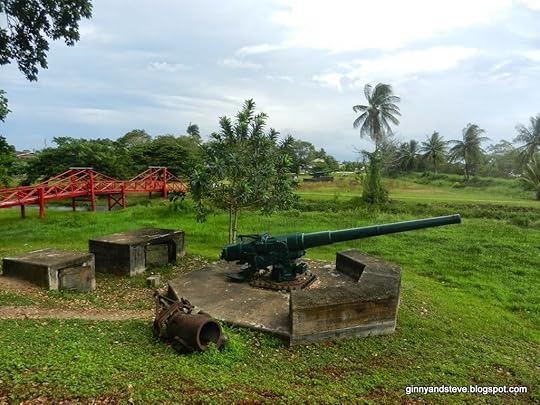
I went to a cyber café and looked at the place in Google Maps. The image showed a perfect five-pointed star where the two rivers join. Curious, I walked there. The star is the moat of a fort built by the Dutch in the 1700’s! It still had cannons of several vintages, including some used to sink a German ship when it tried to enter the river in World War II.
When I got back the tide was out and Thurston was laying in a bed of soft ooze. It didn’t matter because I was going to see Paramaribo, the capital city. I took a ferry across the river, then a bus. The center was of ornate wooden buildings in an old Dutch style. In Cayenne I saw lots of French people, but in Paramaribo I saw no Dutchmen. Now that Suriname is independent its colonial roots seem to lack relevance.
The coast of the Guyanas has no bays, only river mouths. In some cases they are within 65 nautical miles of each other, the distance I can generally cover between sunup and sundown. In other cases they are further apart. It is unsafe to arrive at a new place in the dark, but okay to leave in the dark if you have looked it over in the daytime. The river mouths are deep and north-facing, free of breakers, but they contain hundreds of pilings that the fishermen have sunk into the bottom to hold nets. Even miles from land there may be lines of poles, most no longer in use but still hazardous. I constantly scanned the horizon for them.
There was no high ground, just straight coastlines of salt-tolerant trees. At spring high tides the sea just covers their roots. At low tide the forest is a wilderness of muck and thick vegetation.
In the Coppename River I went up a narrow tidal creek and tied to a mangrove branch. No-see-ums kept getting into the cabin despite my fine-mesh net. Their bites gave me itchy welts. It was hot and stuffy inside, and the mangrove gave off a sour smell. As the tide fell I had to go out and loosen the lines. When the current switched direction I had to re-situate her to stream properly in the center of the creek. As the tide rose I had to clear her of projecting branches that were trapping her downward. Each time no-see-ums got into the cabin.
These days I ate for breakfast what I call “Brazilian Grape Nuts.” In the Guyanas, as in Brazil, manioc flour is popular. Though made from a root, not wheat, it is similar in taste and texture to Grape Nuts! I ate it with milk from paper cartons and chopped fruit. In the tropics foods containing lots of fluids and sugars are the most appealing.
On September 8 I entered Guyana, formerly known as British Guyana. I entered Georgetown, on the Demerara River, but didn’t fare well. The waterfront was all broken-down wharves. A young man frantically gestured for me to tie up at a dock with sagging, uneven beams. He looked suspicious, but I needed a mooring. He tied my line then promptly requested payment for his services! He also warned that my boat would be stripped unless I hired him to watch it. Just then a police boat pulled alongside. One officer told me to climb up onto the dock. By the time I got there another officer had boarded Thurston and was ordering me to come back aboard. They asked me questions and looked blankly at my papers. Finally they told me to report at “the embassy” and left.

The guy who wanted money didn’t know what the place was called either, but it was only two docks away, so I went there. It was a tall, rambling structure containing the Customs and Harbor-master offices. I hadn’t checked into the country, or into Suriname or French Guyana for that matter. Normally I would have, but my friend Peter, the yachtsman we had met in Manaus, had advised me that clearance procedures aren’t enforced. At the Customs office the word “agent” was mentioned. That is a bad word because an agent is someone you have to pay to do a lot of worthless paperwork. “Hey, I’m leaving in the morning,” I said. “I just stopped here to get some sleep!” The harbourmaster finally allowed me to tie alongside a patrol boat provided I didn’t go ashore. I left at dawn with my money intact.
It wasn’t far to the Essequibo, a larger river with several islands in its delta. The coastline now was lined with buildings, the interior having been drained for cultivating rice and sugar cane. Every few miles I passed a canal opening with a tide gate for letting water out but not in.
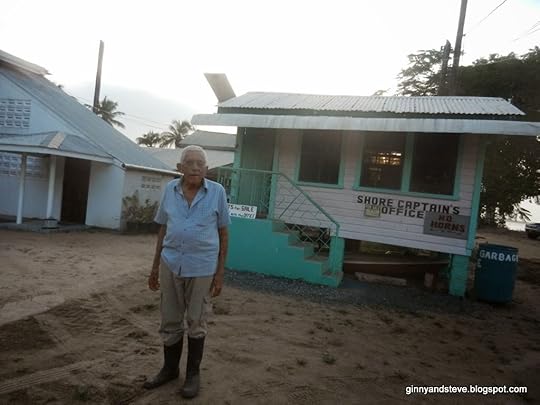
A few miles up I found the marina Peter had recommended. The owner was of Madeiran (Portuguese) ancestry, a former seaman interested in my stories, and in telling his own. He had no place to tie up, just a ramp and sheds full of boats, so he pulled me out on a spare trailer. He charged me nothing. I gave him a copy of my book, Three Years in a 12-Foot Boat, which he savored. The town of Parika was two miles away, Georgetown twenty miles away. I visited both by mini-bus during my week there.
In all three Guyanas the closer I looked the more ethnic schisms I perceived. In French Guyana I was told of a town where the leading language is Portuguese, the second is an Amerindian tongue, the third is Creole, and hardly anyone speaks French! In Albina, Suriname some of the people I passed on the street were Maroons, descendents of runaway slaves that still view the outside world as hostile. They in turn are split into several tribes each speaking a different language! Now, as I rode from Georgetown back to Parika one night, my taxi driver told me how in Guyana, unlike in India, Muslims such as himself get along with the Hindus. I had thought of the East Indians as a single group, but they aren’t. Every time I thought I had a handle on the Guyanas new wrinkles appeared. Generalizations were difficult. They contain such diversity yet they are tiny, numbering only a few hundred thousand people each. They are enclaves of variety in a continent otherwise awash with Spanish- and Portuguese-speakers.
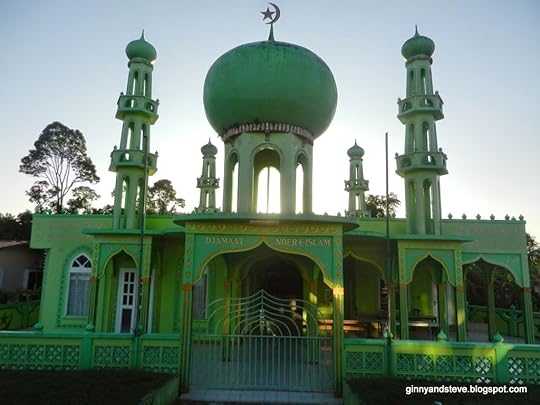
On Sept. 19 I sailed to the Pomeroon River, another uninhabited mangrove bay. In the bright green trees were red and white dots which turned out to be scarlet and white ibises. From there I had planned to travel by interior streams into Venezuela, maybe stopping to visit Jonestown, which wasn’t far out of the way. But I was tired of mud, bugs, and tides, so before it got light I went back out to sea.
When I got twenty miles out a huge storm started gaining on me from behind. It was enormous, and full of violent black energy. Anxious to avoid it I steered further seaward, sped by the faster winds that radiated from it, and tousled by the rougher seas it generated. A gust broke loose one of the
fittings that hold my mainsail, causing it to fly up and flap. I jury-rigged it with a shackle and a piece of rope. Finally the storm drifted over land and I resumed course.
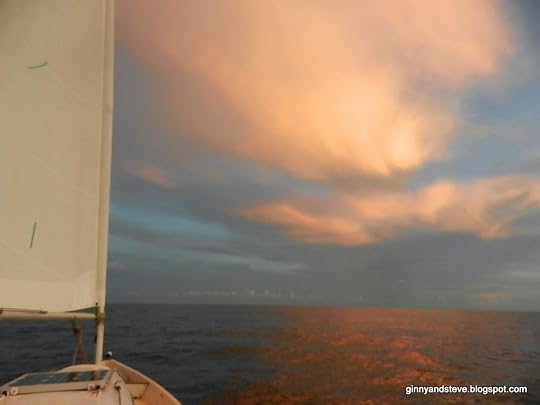
When night fell I felt very alone. I’m still not used to the open sea. This time there was no moon. As the hours dragged on I fought the urge to look at my watch. Using a headlamp with a red light to avoid spoiling my night vision I constantly checked my GPS and steered to keep it’s red arrow vertical. (When you tell it to navigate to a waypoint it gives you an arrow which rotates left or right when you go off course.) Fortunately the wind died down to a steady ten knots and the waves became regular. With the wind directly astern I put one sail to starboard and the other to port and positioned the tiller to hold her on course. I buckled into my harness, leaned against the lazarette, and slipped into and out of sleep. Twice I saw a brilliant light, slowly gained on it, and slowly passed it. They were big trawlers travelling slowly in the same direction as me. I had to stay awake while in their vicinity to avoid risk of collision.
When sailing west it is best to make landfall in the morning or early afternoon, before the sun drops low enough to blind you. On the Guyana coast the shoals and high tidal range further restrict the time window, it being undesirable to arrive at low tide. Preferably one arrives in the latter half of a rising tide, with the shoals covered and the current in one’s favour. In the morning the east wind has an off-shore component (comes from the southeast) whereas in the afternoon it has an on-shore component (comes from the northeast). On the complex Guyana coast one must consider all these factors.
In this instance it was unwise to aim for the Waini River, on the Guyana/Venezuela border, but propitious to target Cańo Guiniguina, a mouth halfway around the Orinoco’s fan-shaped delta. By the time I sighted land, thirty hours after leaving the Pomeroon River, the wind had almost disappeared. The surface waves were now only glittery wrinkles on the surface of big, round swells passing underneath me, like house-sized balls rolling under a blanket.
Just inside the opening I passed an Indian hamlet, two or three houses of crude thatch. Further on I stopped at a raft consisting of plastic drums lashed together, covered by a plastic tarp, anchored away from shore to escape bugs. I visited with a dozen men, the crews of three open fishing boats. Then I gave them a big buoy I had found during the passage, probably lost by one of those big trawlers. I also gave them 100 bolivares, worth about five dollars, which I had left over from when we were in Venezuela. I wasn’t going to need them. The gifts were probably unnecessary in terms of good will, but it was reassuring to have friends nearby as I dropped anchor and cooked a much-deferred meal. Thunder rumbled through much of the night but again the storm passed someplace else.
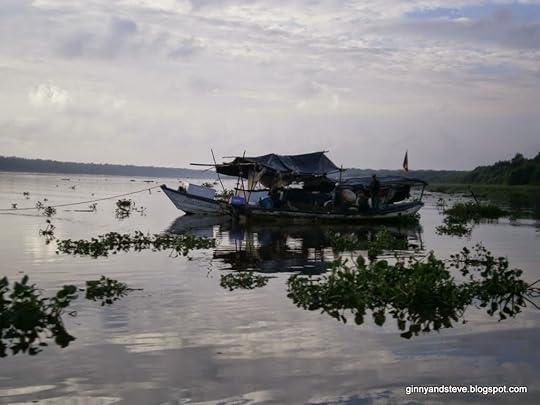
I was out of the Guyanas. The bottom was firmer now. The Orinoco water was a glossy, translucent brown, not the opaque tan of the Amazon and the Essequibo. The following night I took refuge behind Punta Pescador, where I had stopped in 1992 as well, and the next day I rounded the point into the Gulf of Paria. To my right were the beaches, palm trees, and hills of Trinidad. Two days later I was here at Chaguaramas, a yachting center just west of Port of Spain, the capital.
Our friends from the Rio Negro days, Peter and his lovely wife Louise, had arranged a free haulout for Thurston next to their power yacht, the Passagemaker. I spent a few days recuperating in luxury at their beautiful Amazon Lodge and now I am living aboard the Passagemaker as I write this. Thank you Peter and Louise for helping me prepare for the next leg back to my family!
Steve Ladd
For more photos see
Published on October 11, 2014 13:04
September 2, 2014
St. Laurent, French Guyana
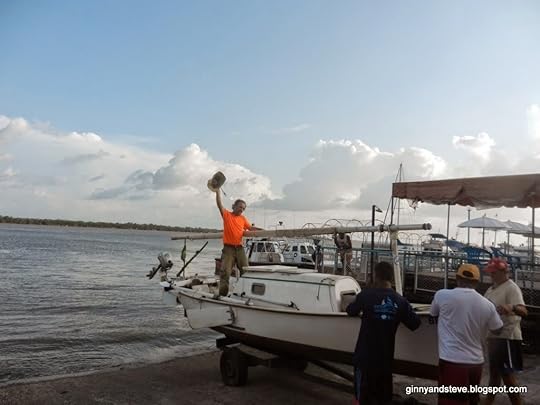
Dear friends and family,
We last wrote to you as guests of the municipal marina in Belém, Brazil. The employees and boat-owners there were exceptionally kind. From the second-story of a huge shed where boats were parked we occasionally had a free wi-fi signal. Mosquitoes were a problem and the bathrooms left much to be desired, but we had a safe, secure place and were never asked to pay anything. Thurston was parked on land next to where a rowing club had its boats. The rowers came every morning to work out. We became friends. They always checked in on George and asked, “Are you going to row today, Jorge?”
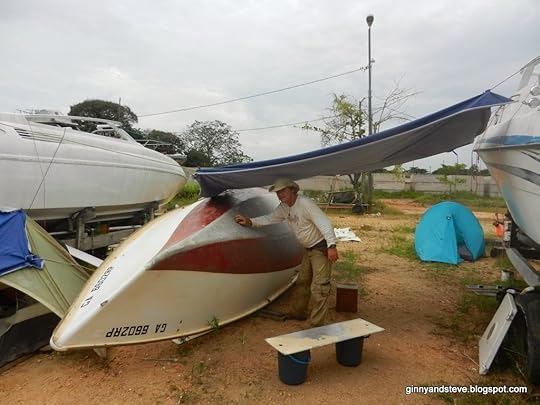
We repainted parts of the boat, made a new way to hold the oars when not in use, and filled more holes in the bow, where five years of plowing onto things had taken a toll. New friends drove us around town. While not keeping George out of mischief Ginny taught Steve how to use the software for mapping and photography. Steve researched navigational problems, including the dreaded pororoca, the tidal wave that terrorizes certain areas around the mouth of the Amazon River at times of extreme tidal flux. People surf it! Fortunately it is only extreme in February and March.
The city had over a million inhabitants. The waterfront was mostly dangerous slums but it got cleaner and more prosperous inland. We sometimes walked around the old business district under the scortching sun on some boring errand or another. Perhaps looking for a little hat for George or some new bowls to eat out of. Ginny memorized the shops in town offering free tiny cups of coffee and we made our rounds accordingly.
Brazil wanted so badly to win the 2014 World Cup of which they were hosts! The people prepped for astronomic celebrations, but their star player got injured while playing Colombia so they lost to Germany and Holland. The Brazilians took their defeat in stride and we missed out on the party of the century.
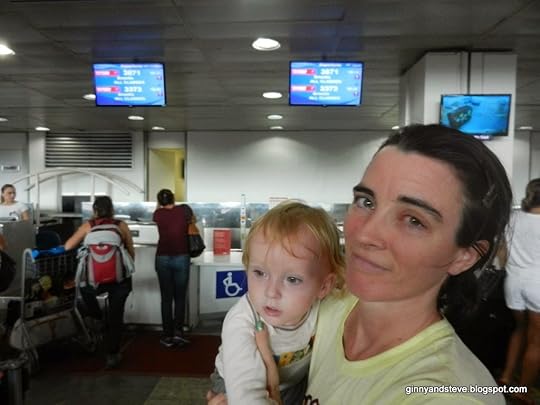
On July 17 came the separation we had been dreading. Ginny and George flew to Los Angeles. Ginny kept her homecoming a secret from her mother and grandmother, and scored a big surprise. Since we ran away together in 2007 we had never been apart for more than a few days. We love each other deeply. Can we handle it? My job now (Steve writing in the first person) is to sail back as quickly and as safely as possible.
Suddenly the boat was super-roomy! I felt guilty re-arranging everything to my liking, in all our former battlegrounds of space usage, but if I have to be lonely I might as well be comfortable. With George and Ginny no longer in residence I was also able to turn Thurston upside-down, fill dings in the bottom, and add a layer of fiberglass. Then I improved stowage in the forepeak by making a triangular box for boat-repair chemicals, on the lid of which I stow the heavy anchor and rode.
Belém is on the Pará River which, like Argentina’s Rio de la Plata, is not so much a river as a common mouth for several rivers. The Pará is connected to the Amazon by the tidal streams that form the western edge of Ilha de Marajó, which is 170 miles from east to west and 120 miles from north to south. The Pará’s mouth is southeast of Marajó Island, the Amazon’s is northwest of it. Yet the entire complex can be considered a single delta.
From Belém I planned to travel west around Ilha Marajó then exit via the Amazon. That way I would stay in rivers as long as possible and delay entering the Atlantic. But I changed my plans upon talking with my Russian friends, Anton and Julia.
Their boat was the Scalawag, an old 37-foot fiberglass cutter built in the U.S. They had already tried twice to leave via the Pará mouth and each time were defeated by engine problems and strong currents. The second time they were attacked by pirates to boot. They were ready to try again. This time they would leave at the half moon, when the tides are in neap and the are currents slower.
I liked the idea of catching the neap, which was only three days away, but from Belém to the ten-meter contour outside the mouth was 170 nautical miles, the latter half among treacherous shoals. I could never stay awake long enough to clear the danger zone, so I asked if they would tow me out the mouth. They agreed. I got a clearance for Trinidad. My hosts launched Thurston for me, and early on the morning of August 6, 2014 the Scalawag towed Thurston out into the Pará River.

We were still within sight of Belém when the Scalawag lurched to a halt. We had ran aground, though the chart showed two meters. The tide was falling so we had to wait. By noon she was high and dry on a ribbon of sand. We set out anchors and dug a pit to facilitate turning the keel. As the water came up we winched her around until the bow faced deep water. Finally the keel lifted and we motored off.
Where solid land ended we waited for the tide to change again. A three-knot current pulled the anchor chain straight as a rod. During the night a new sound brought us up on deck. A fishing net had gotten draped over the chain. While we wondered what to do a boat came close. They did something, and the net slipped away. Back to bed.
In the morning favorable currents helped us get out past the critical zone where navigable channels are interspersed with shoals that break at low tide. When we reached the ten-meter depth contour we turned northwest, toward French Guyana. But the sea was too rough to separate so we continued together through a third night.
I had slept much of the day so at 9:00 p.m. took the helm. I sailed Scalawag through fleet after fleet of fishing boats, knowing each had a net several kilometers long that could catch on a hull appendage. Whenever I thought I had passed the last boat more lights appeared on the horizon. Innumerable small wooden fishing boats were working these shallows fifty miles from land.
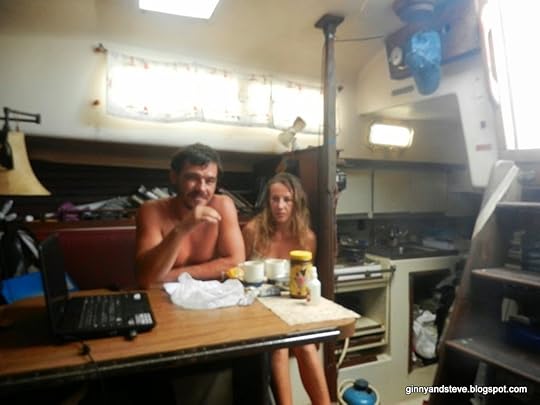
At 3:00 a.m. Julia came on deck. The wind and waves were high. We were completely surrounded by fishing boats. She spoke no English, I spoke no Russian, so we got Anton up. They started bickering about something. Suddenly Scalawag stopped dead in the water while Thurston streamed ahead until arrested by the tow line. We had snagged a net.
A long net is the ultimate sea anchor. It doesn’t move, whereas Scalawag and Thurston wanted to be blown downwind. The matter seemed to resolve itself when the net slipped free of Scalawag’s hull, but then it caught on the tow line connecting the two boats. Now the net was upwind, the boats downwind side-by-side. I swam to Thurston and untied the tow line, hoping Anton could pull it through from his end, but it was stuck. So I sat on Thurston’s bow and pulled hand-over-hand until I reached the net. The strain had caused it to snarl around the tow line. The best I could do was cut the line – actually my main anchor rode - on either side of the snarl and save the two halves. By this time Scalawag had snagged again, but the wind and waves were dying. In a couple hours it would be light, so we all went to sleep.
At dawn we freed Scalawag. It was a good time to separate, so I got my things and departed. By the time I had put Thurston in order and raised her masts Scalawag had disappeared.
The down-side to having exited via the Pará mouth was that I now had about 250 miles to travel before I would find a safe refuge, further than any of my previous passages. I would spend three nights adrift, difficult in Thurston because she rocks so violently.
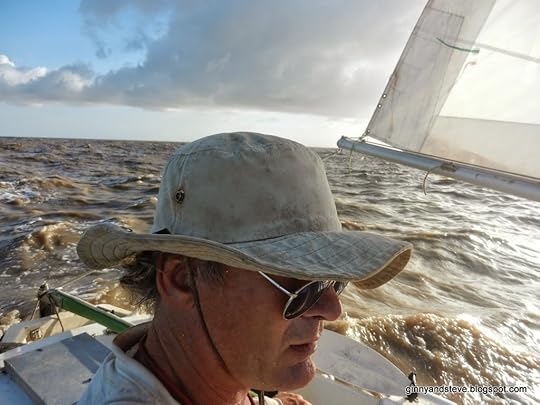
The wind soon built to twenty knots from the east, an ideal angle. I positively flew all day, deeply reefed, the waves hissing as they slowly overtook me. At sunset I dropped my sea anchor, a cloth parachute attached to the bow by a stout line. The GPS now showed that a current was pulling me west at five knots. The speed and direction varied during the night as the tidal waters swirled. The wind stayed strong. Thurston oscillated once per second, to such an angle that the gunwales sometimes dipped under the water, obliging me to leave the cockpit drain open so water wouldn’t accumulate. Laying normally was impossible so I curled up in a fetal position transversely to the narrow hull so the roll would act on me longitudinally instead of laterally, and slept fairly well.
The next day I sailed fast through alternating green ocean water and brown river water, still about fifty miles off-shore. Suddenly the GPS said I was going east, though the compass said I was going northwest! What current could possibly do that? After a half hour it disappeared and I was going northwest again. Without the GPS I’d never have perceived the deviation. I fought drowsiness by singing songs. I heard voices, but knew they were from the dreams I kept falling into and shaking myself out of.
My second night at sea anchor went badly. The sea anchor dragged me over a shoal only five meters deep according to the charts. The strong wind running contrary to the current created short, steep waves, like in a river. So at 9:00 p.m. I got back underway. When I regained the ten-meter contour I stopped, but after a couple hours fishing boats got close so I had to sail again. I slept little.
On my third day alone I saw no boats. At times I was able to adjust the controls to make Thurston self-steer, and got some blessed sleep. This was fortunate, because my third night at sea anchor was also nearly sleepless.
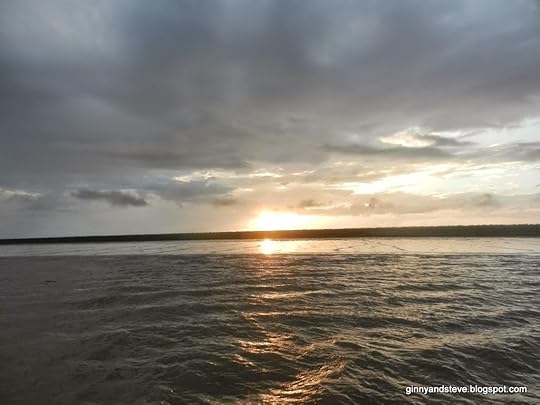
On day four I was anxious to reach the shelter of Cabo Cassiporé. When the wind became light I cranked up the motor and added its propulsion to that of the sails. Low jungle became visible to port. I passed schools of large, silver fish that swam close together on the surface, their gaping round mouths open as if ingesting water. Some bashed against my boat. When I finally reached the cape, scores of scarlet ibises and flamingos took flight from a wall of verdant trees, then re-landed. I tied to a snag in the bay behind the cape. There was no real land, just sea-level swamp and mudflats. The ebb tide laid Thurston down in bottomless muck, but the flood tide lifted her back up again. High tide at sunset is a blessing because you have it again at dawn and can leave. When low tide is at sunset you have to stay further out, and get less protection.
The next day I sailed around Cabo Orange, often sitting in the shadow of my mizzen sail to escape the broiling rays of the sun. I stayed a couple miles from land but it wasn’t enough. I kept encountering muck only a few inches below the surface of the sea, and had to steer further out. These capes are merely deposition sites for the immense volume of silt coming out of the Amazon River.
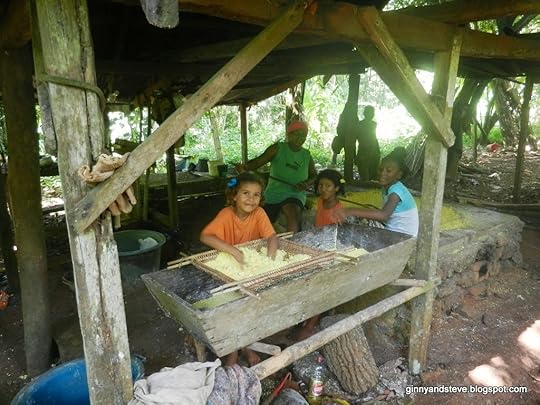
Rounding Cabo Orange I left Brazil and entered French Guyana. In a small river mouth I found the village of Ouanary, with a population of under one hundred. Street lights and flowering shrubs adorned the lane running into town! Black women wearing colorful, flowing garb said “Bonjour” as I passed. There were no cars or motorbikes, just a few quads running on paved tracks. The school teacher, a huge man with a booming laugh, let me use his computer so I could email Ginny that I was okay, out of Brazil and in a fascinating new country.
Sitting in his empty schoolroom I spliced my anchor line back together. I washed my clothes, and hiked to the top of a small mountain. The view was of endless virgin jungle. At the teacher’s house the TV played the news from Paris. French Guyana is actually part of France, like Hawaii and Alaska are parts of the United States. Everyone had decent homes and lived well with generous welfare benefits. The people spoke French Creole, and to a lesser extent French. There were also a lot of Brazilians mining the rivers for gold and coming into Ouanary for government assistance. Though illegal they were tolerated.

Two days later I reached Cayenne, French Guyana’s largest city though its population is only 50,000. I anchored in the harbor and got rides to the wharf from Venezuelan fishermen on a nearby boat. The town was full of Gallic charm, with two- and three-story buildings, wood or masonry, in old colonial styles. The public infrastructure was excellent, the streets clean. Less sanitary was a narrow channel into which fishing boats of several nationalities squeezed to sell fish, refit their boats, and replenish their provisions. Here Creole, French, Brazilian Portuguese, Venezuelan Spanish, and Guyanese English were spoken equally. I chose not to stay there because the water was full of fish offal. I bought groceries at a modern supermarket stocked with goods from France. On top of the hill was a fort with a plaque telling how in 1647 Dutch attackers captured the fort, but the French valorously won it back.
On August 20 I sailed to Devil’s Island, where the Papillon story took place. Actually it is a cluster of three palm-covered islands. The prison colony is now a resort/nature preserve. Several excursion catamarans were there with tourists from the nearby town of Kourou, site of the European Space Agency’s Guyana missile center. As luck would have it, an Ariane rocket was due to launch that evening so everyone had to leave. The authorities cleared the area lest the rocket blow up, showering the area with fragments. So I sailed into the mouth of the Kourou River and slept there.
A couple days later I reached the Maroni River, the boundary between French Guyana and Suriname. Fifteen miles upriver lay St. Laurent, on the French side, and Albina, Suriname. There was no bridge. Traffic between them was via a multitude of wooden canoes thirty to forty feet long. This boat consists of a dug-out bottom to which freeboard is added by attaching thick slabs of wood on the sides. At the bow and stern the bottom bends up to form large spoon-shaped appendages. Their two-stroke outboards created a constant buzzing sound.

The shores on both sides were busy with people and merchandise coming and going, but in Albina I found a house with a beach in front where I was allowed to stay. I laid a stern anchor and tied the bow to a tree. At high tide I was afloat and able to wade ashore. At low tide I was beached.
The people of Albina presented a confusing mix! They mostly spoke an English-based Creole language unique to Suriname, but everyone also spoke Dutch, the official language. Most people understood some English and French. As if that weren’t enough, Amerindians spoke their own languages, as did the mysterious “Bush Blacks,” who in English are called Maroons. In addition to the usual European, Amerindian, and African blood lines, one saw Asian Indians and Indonesians as well, from other parts of the former Dutch Empire.
Albina was garbage-strewn and drab. The people were rather poor, Suriname having had a difficult history since separating from Holland in the 1970s. Rastafarians hustled aggressively along the waterfront. Many of them had dreadlocks tucked into voluminous knit bags and pants worn so as to display their fine buttocks. I was warned not to go out after dark.
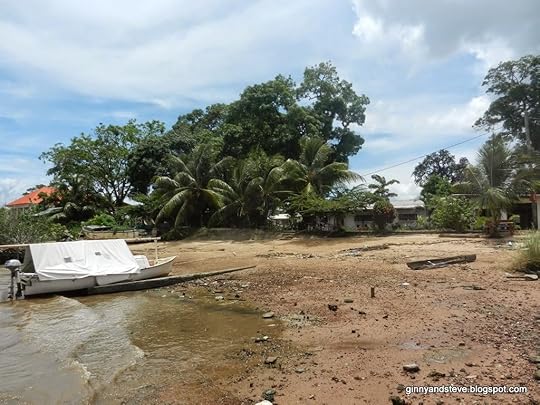
It was a good place to work. I made new holders for my GPS, the previous device for holding it at eye level on the mizzen mast having broken. The house in front of which I stayed doubled as a sort of restaurant. They had no sign, but in the evening a few people would come around to drink beer and dance to music that sounded vaguely Caribbean. They served me roti, a meal of chicken and potato wrapped in an unleavened slab of bread.
I stayed in Albina until August 27 then crossed over to St. Laurent. It was a lovely town, with clean streets, wide sidewalks, and charming colonial architecture. The town began as another penal colony, and the old prison, hospital, gendarmerie, etc. were still in good condition. Despite newer additions the historic ambiance has been maintained.
There were half a dozen cruising yachts anchored in front of the town. Some had stayed for years. I anchored next to a wrecked ship that has become an island due to trees growing up inside it, and each day tied up at a nearby floating dock in order to go into town. It was so pleasant I decided to stay and write this email there.
After this I sail to Paramaribo, capital of Suriname. In the meantime after spending a month in Los Angeles with Ginny's mom and Grandma Ginny and George are back home in Bremerton, awaiting my return impatiently.

New photos may be found at: https://picasaweb.google.com/ginnygoon/FrenchGuyana
Lots of love,
Steve, Ginny, & George
Published on September 02, 2014 16:43
July 18, 2014
Belem, Brasil Mass Email

Dear friends and family,
We last wrote you from Marabá in the state of Pará, Brasil, on the Tocantins River. When we left there, on May 28, we weren’t in a hurry, yet we rarely stopped because shade and trails for walking were hard to find on shore. It was more comfortable to keep going than to stop.
Rowing and motoring downstream we soon reached the reservoir of Tucuruí Dam. The surrounding hilly jungle distinguished it from the low, dry land we had experienced on the Paraná River reservoirs. The water was like that of the Rio Negro: translucent black and devoid of mosquitoes. Hundreds of tall islands dotted the lake, but they were generally inaccessible due to natural hedges composed of a plant reminiscent of a ten-foot-tall asparagus growing densely on the banks and on the immersed foreshore. Our best campsite was on a small island where someone had cleared just enough to step ashore. Inside the perimeter the rainforest was virgin and relatively open, the trees tall and large-leafed. We hiked to the top of the single hill which made up the island, trudging through deep forest litter. The tree cover was too dense for views, but it was good to reacquaint ourselves with the rich, clean Amazonian smells.
 After three days travelling north on the lake we reached the 75-meter-tall Tucuruí Dam. They wouldn’t lock us through, so we found a cheap transport to a ramp below the dam in the city of Tucuruí, population 100,000. The common launch now was a wooden boat 20-30 feet long with a Diesel engine, a steering station forward, and a stern so long and tapering that no weight could be carried aft of amidships. A seaman of a bygone era would have described them as having “cod’s heads and mackerel tails,” in contrast to the modern tendency of boats to be wider in the stern. These streamlined vessels were gracefully fitted with a variety of roofs and cabins, and their paint jobs were often quite beautiful.
After three days travelling north on the lake we reached the 75-meter-tall Tucuruí Dam. They wouldn’t lock us through, so we found a cheap transport to a ramp below the dam in the city of Tucuruí, population 100,000. The common launch now was a wooden boat 20-30 feet long with a Diesel engine, a steering station forward, and a stern so long and tapering that no weight could be carried aft of amidships. A seaman of a bygone era would have described them as having “cod’s heads and mackerel tails,” in contrast to the modern tendency of boats to be wider in the stern. These streamlined vessels were gracefully fitted with a variety of roofs and cabins, and their paint jobs were often quite beautiful.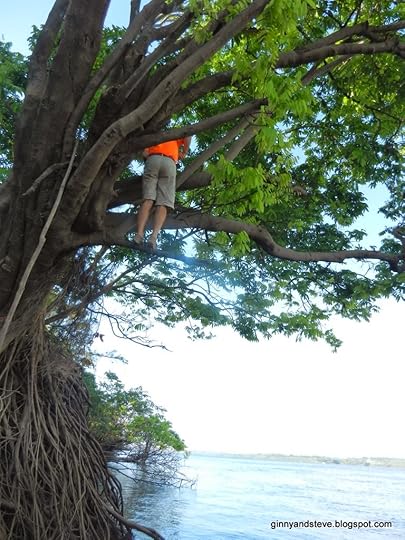
The river level dropped nine feet each night and rose again in the morning, presumably due to uneven operation of the dam’s hydroelectric plant. To avoid drying out we crossed the swift, mile-wide river and found a steep bank with an overhanging branch to tie to. Here we dropped and rose without unpleasant surprises. We learned to loop the line over the branch and back to the boat to avoid having to climb the tree in the morning! We stayed several days, protected from the storms that blew from the east, shifting in the morning to an adjoining beach with shade trees where we could work on our projects while George played in the sand. In the afternoon we crossed over to the city for errands, then returned at dusk to our secluded spot.
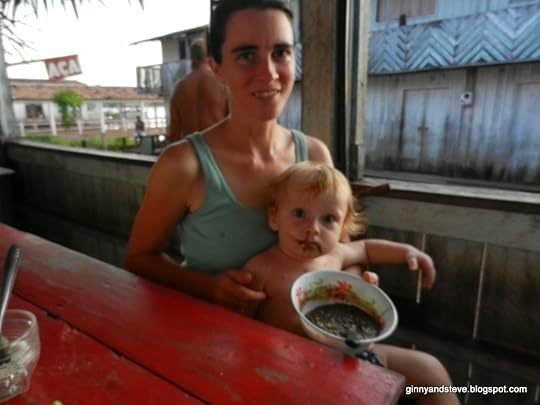 As we continued downstream a powerful oceanic tide started combining with the dam’s artificial tides, confusing us totally as to when we might rise or fall. In the riverside communities the boats were moored to tall poles set in the river bed. The streets were of bare dirt, the houses of stained planks. Yellow school boats brought outlying children into town for school. On the docks were burlap bags full of acaí, an un-sweet fruit that looks like a purple grape. The locals boil it into a pulp and consume in vast quantities.
As we continued downstream a powerful oceanic tide started combining with the dam’s artificial tides, confusing us totally as to when we might rise or fall. In the riverside communities the boats were moored to tall poles set in the river bed. The streets were of bare dirt, the houses of stained planks. Yellow school boats brought outlying children into town for school. On the docks were burlap bags full of acaí, an un-sweet fruit that looks like a purple grape. The locals boil it into a pulp and consume in vast quantities.Our last town on the Tocantins was Baiáo. A woman we had met in Sao Paulo, a friend of our couch-surfing hosts there, was from Baiáo and had arranged for us to stay with her mother. We found her and a grown nephew living in a modest brick house near the port. She put us in a spare bedroom and immediately began serving us the famous foods of Pará, including manisoba, consisting of a certain leaf that has to be cooked for a week! It was nice to be made to feel at home with such giving people. Steve took the opportunity to fiberglass and paint Thurston’s weather-worn tiller.

When we left on June 14th the river quickly widened. The land-less horizons looked like the ocean, but the Atlantic was still a hundred miles away. Now a current ran against us on the rising tide.
On the 16th, just shy of the Tocantins’s juncture with the Rio Pará, we opted for a sheltered back route into Belém by turning east into a maze of islands and tidal rivers. We learned to wait out periods of contrary current, but the usual six hours of flood followed by six hours of ebb was complicated by how the waterways branched and joined at odd angles; we never knew how the current would run in the next segment. The land was low and swampy, the shoreline lined with shacks on stilts. The houses often had large boats propped up next to them, the explanation being, of course, that they had come at a high tide and could leave at another high tide. Being unable for several days to go ashore was a burden for George who, at fifteen months, was eager to exercise his wobbly little legs. He compensated by standing in the companion-way and marching in place!
 Everything moved by river. Each community’s waterfront was a bee’s hive of boats loaded with bricks or fish traps or people. We even passed a boat transporting heavier-than-water logs. Several of these massive trunks, as long as the boat, were suspended from each side, below the waterline, parallel to the keel. Members running transversely across the gunwales supported the heavy ropes that looped down and cradled them.
Everything moved by river. Each community’s waterfront was a bee’s hive of boats loaded with bricks or fish traps or people. We even passed a boat transporting heavier-than-water logs. Several of these massive trunks, as long as the boat, were suspended from each side, below the waterline, parallel to the keel. Members running transversely across the gunwales supported the heavy ropes that looped down and cradled them.The waterways became small, then big again as we approached Belém, at the southern margin of the vast Amazon delta. On June 19th we reached this city of one-and-half million inhabitants. Our final approach was across a mile-wide channel which was ebbing swiftly; forcing us to angle sharply into the current to cut across. The skyline was a mass of high-rises while the waterfront was an chaotic succession of docks, sawmills, and boatyards.
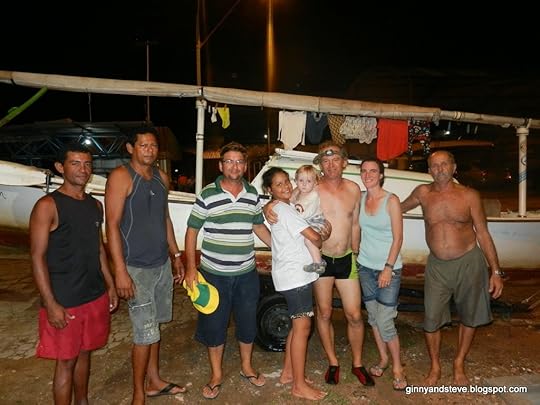 We found a yacht club we had heard about, and were immediately welcomed. Their dock was unprotected, but a sailing instructor with an extra trailer soon hauled us out and set among a hundred other boats in a big fenced area. Two other foreign vessels were present, a Swedish yacht with a female single-handed skipper named Eva, and a boat with a Russian couple that had recently been robbed by pirates while anchored at a nearby island. “The joke was on them,” said Anton, “because our stuff was mostly broken!” Now they were waiting for a new starter motor so they could escape to Trinidad.
We found a yacht club we had heard about, and were immediately welcomed. Their dock was unprotected, but a sailing instructor with an extra trailer soon hauled us out and set among a hundred other boats in a big fenced area. Two other foreign vessels were present, a Swedish yacht with a female single-handed skipper named Eva, and a boat with a Russian couple that had recently been robbed by pirates while anchored at a nearby island. “The joke was on them,” said Anton, “because our stuff was mostly broken!” Now they were waiting for a new starter motor so they could escape to Trinidad.Thurston was still on the trailer, so we used old tires and our aluminum floorboards to make steps. Someone gave us a worn-out boat cover, which we stretched out between tall boats to either side for shade. To make more room in the boat we pitched our tent and put a lot of our stuff in it. The nights were cool but by noon the sun and humidity bathed everything in suffocating heat. In the afternoon an intense storm usually hit, testing the web of ropes stretching our tarps and covering the ground with an inch of water. And this is the dry season! Steve finally broke down and bought a pair of flip-flops, the standard Brazilian footwear.

Belém, founded in 1616, is densely built on a low peninsula. The Old City, twenty minutes away by bus, was very beautiful, but slums were more prevalent. Beyond the marina gate the neighborhood was tumultuous and fetid. Drainage and sanitation were sorely lacking. Our immune systems were in a state of constant challenge, challenges we sometimes lost. Loudspeaker cars passed by piping out commercial spiels. Over-amplified music emanated here and there. We had a lot of work to get ready for the next phase of this voyage. New-found friends took us looking for epoxy, fiberglass, paint, etc.
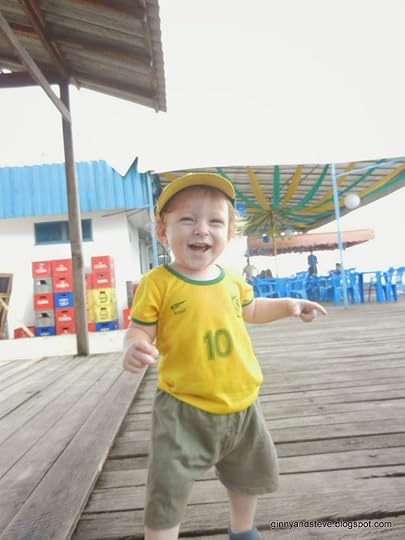 The World Cup was going on and Brazil was host. Yellow-and-green flags and bunting filled the streets. When Brazil played every house and store had a TV tuned in. When Brazil scored a goal you knew it from the fireworks and horn blasts all over the city. They even rang the church bells!
The World Cup was going on and Brazil was host. Yellow-and-green flags and bunting filled the streets. When Brazil played every house and store had a TV tuned in. When Brazil scored a goal you knew it from the fireworks and horn blasts all over the city. They even rang the church bells!The Brazilians use the word saudade (sow-dáw-jee) a lot. It means tenderness, or a longing for loved ones. The word applies to us with a vengeance now, because on July 17 Ginny and George took the red-eye to Los Angeles, where her mother and grandmother live. We always knew this day would come, because the sea would not be safe for George. Steve will single-hand Thurston back to Florida.
Some new photos may be found at: https://picasaweb.google.com/ginnygoon/BrasilPt5
Lots of love,
Steve, Ginny, & George
Published on July 18, 2014 14:19
May 27, 2014
Maraba, Para, Brasil - Mass email

Dear friends and family,
Should one travel slowly, relishing each unique locale, or fast, knowing as many lands as possible? Right or wrong, we have always roamed toward the vigorous end of the scale. We enter a place, walk it, talk to some people, then move on before it gets stale.
It has been seven years since we ran away together, first in the little pickup truck with a canoe on top, then in Thurston. To help keep our memories straight we often play a game whereby one of us, reminiscing on a town or campsite, gives the other clues until they guess it, which they usually do rather quickly.
Lately, however, we have been experiencing “town blur” as we descended the Araguaia River quickly in order to reach the Xambioá rapids before the low-water season. It doesn’t help that many towns have had similar names: Aragarças, Aruaná, Araguacema, and Araguaná, for example. We were there so recently, yet we need quite a few clues to distinguish one from another in our memories.
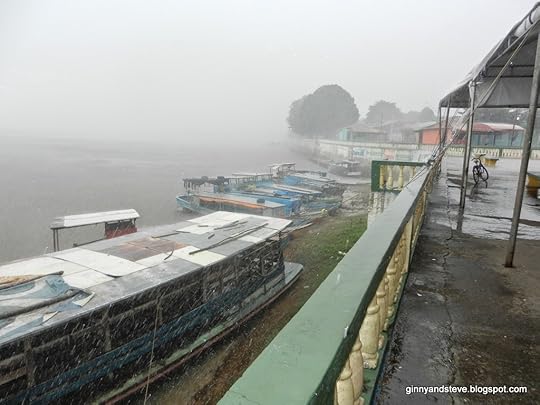 We last wrote from Conceicáo, Pará, where a pawn-broker named Geraldinho (Little Gerald) welcomed us into his home. Steve plugged our laptop into an outlet, sat in a corner, and typed. Later Ginny uploaded photos at a cyber café while Steve, with George on his back, explored the city’s edges, where paved streets became dirt, the houses became poorer, and green hills poked up in the distance. It was hot, and whoever carries George in the carrier can’t reach around behind, so Steve periodically stopped at shops and asked the proprietors to feed him some water, which they were ecstatic to do.
We last wrote from Conceicáo, Pará, where a pawn-broker named Geraldinho (Little Gerald) welcomed us into his home. Steve plugged our laptop into an outlet, sat in a corner, and typed. Later Ginny uploaded photos at a cyber café while Steve, with George on his back, explored the city’s edges, where paved streets became dirt, the houses became poorer, and green hills poked up in the distance. It was hot, and whoever carries George in the carrier can’t reach around behind, so Steve periodically stopped at shops and asked the proprietors to feed him some water, which they were ecstatic to do.On May 15 we left Conceicáo. We rowed two hours per day and motored maybe six on average. Now and then we passed a planked canoe with a little-tail motor. Whereas in Barra do Garças the dry season had fully arrived, here we started experiencing brief but fierce storms of wind and rain, thunder and lightning. The tempests always came from the east, so we learned to camp on the east bank, where the waves couldn’t build. The days remained seeringly hot, and the nights offered little relief. Ginny’s heat rash has spread all over her back.
The land became higher, less swampy. Tall, wispy palm trees appeared. Lagoons and creeks became rare. Dense emergent brush grew along the shores, making it difficult to reach land. Often a floated line ran along just outside the brush with short hooked lines dangling every couple feet, for intercepting the fish that hang out in the immersed vegetation.
In the towns, in addition to brick houses we now saw wooden ones as well, with vertical plank siding and thatched roofs. The waterfronts often had rustic shelters, half underwater, where beer and snacks would be served when “summer” arrived and the beaches became exposed. The locals spoke eagerly of the crowds that would then flock from all over to party, enlivening the local economy. For now, though, these settlements were quiet.

People hearing us talk together sometimes overcame their shyness and initiated conversations. English is greatly esteemed in Brazil. Many knew some words but few had heard it spoken except in movies. Most people were of mixed European, African, and Native American descent. They often marveled at the whiteness of George’s skin and the blueness of his eyes.
Our GPS maps being based on low water, the rocks they showed were still covered. In these places the river roiled and ran two or three knots faster than usual, nothing more. We hoped that we could also transit the serious rapids that commence at Xambioá (the “X” is pronounced “Sh”), but upon arrival in this lovely town on the Tocantins side, refreshingly hilly after so many flat places, we learned otherwise. The local boatmen, who earn their living ferrying people to a sister city across the river, decided that it wouldn’t be safe even to tow us through. Just downstream of Xambioá is a long rapid whose roar is audible from town, and after a gap comes another rock-patch extending to a point sixty kilometers downstream. A month sooner high water would have covered all the rocks, but now they were exposed, and the whirlpools and gushers were too violent in an under-powered boat such as ours.
Fortunately, across the street there lived a man with a long flat-bed truck. He had no engagements and his price was reasonable, so we reconvened at a nearby ramp where many hands helped load Thurston, and we were off on our twelfth transport.

Our route took us down seventy kilometers of paved highway then fifty kilometers of rough dirt road with little traffic. We passed through rangeland and forest, arriving finally at a hamlet called Antonina where there was a ferry to the Pará side. Ferry employees, an agricultural inspector, and a local teenager helped us lower Thurston into the water.
Relieved at having passed the rapids, but sorry we wouldn’t see them, we spent half a day observing life at this remote ferry crossing. Antonina had about ten humble houses and an open store/bar. Now and then a vehicle would appear. If arriving at the other side they would honk their horn to make their presence known. Then the skipper would saunter down to the landing and fire up the diesel in a tugboat whose bow was attached, via a pivot, to the midpoint on the downstream side of a barge. A deckhand raised the ramp. The skipper, pushing with his propeller and rudder, rotated the boat 180 degrees while the barge remained stationary. Then they chugged to the other side, lowered the ramp, and picked up their passengers, whom they seemed to know well. When the sun went down we drank beers at a patio overlooking the river, while George played with local children and two men tinkered with a little-tail motor.
In the Araguaia’s final two hundred kilometers it flows through wild forest. We passed through long stretches where patches of emerging brush, and barely-submerged rocks, pocked the surface of the mile-wide river. There was no main channel, just an imponderable volume of greenish-brown water passing through a sieve of rough bedrock. We kept our eyes well ahead, picking our route, slipping over low shelves, swirling left and right as the water sucked and surged, not violently, but impressively.
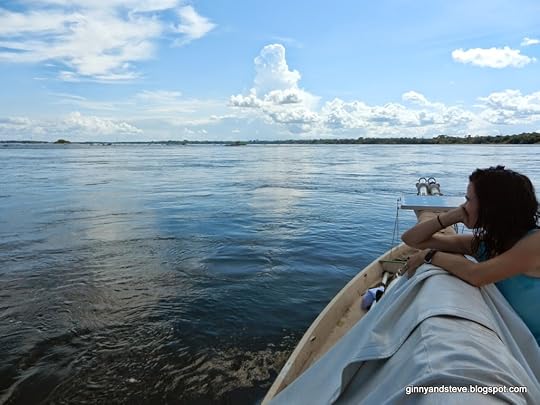
On May 21 we reached the juncture of the Araguaia and Tocantins rivers. Though the Tocantins is the smaller of the two, its name applies to the combined stream, so we had finished with the Araguaia. Downstream there would be no more rapids, and the state of Pará would occupy both banks.
Later that day we went under a bridge, passed a flat where upside-down boats were being caulked and tarred, and reached Marabá, population 230,000, on the left bank. Needing to extend our tourist visas, we hiked blindly away from the river, asking directions to the Policia Federal. We eventually found it and got another ninety days. In the process we learned that this city is divided into three parts, separated by large expanses of swampy floodplain.
The only section of interest to us now is Marabá Pioneira, the old town. Here the houses are small and the sidewalks are a mish-mash of irregular and broken surfaces, often encumbered by rubble. The riverfront is a tall seawall with park benches on top and, at intervals, stairways leading down into the river. We are tied to a heavy, 30-foot wooden passenger boat, one of about ten at this landing, whose livelihood is to carry passengers to a party beach on an island in the river. The beach is visible from here, a line of colorful tents and golden sand, surrounded by boats, with music loud even from a kilometer away.

The boatmen are expert. On a busy Sunday afternoon they zip back and forth, their open, roofed craft crowded with gay passengers, their poorly-muffled Diesels bellowing and belching smoke. The landing is crude: just a narrow stairway disappearing into the river and a makeshift float streaming parallel to the waterfront. They compensate for the current and jostle each other to get their bows onto the stairway so their passengers can clamber on and off. When the sun goes down and everyone wants to go home at the same time, they squeeze in together at the landing, newcomers wedging their sharp bows and round bellies between the other boats. When the skipper has finished his loading he stands on a stern deck, pushes a tiller hard over, and gives a deep pull to a string by which opens his throttle. “Brraammm!” and he’s gone.
There is a park here with a play area covered with shiny brown pebbles that George loves, and good shade trees. A new friend has made their living room and electrical outlet available to us. Here we write.
Some new photos may be found at: https://picasaweb.google.com/ginnygoon/Brasilpart4
Lots of love,Steve, Ginny, & George
Published on May 27, 2014 05:24
May 14, 2014
Concei��ao do Araguaia, Mass Email

Dearfriends and family,
We last emailed you fromBarra do Gar��as, Brazil, where we awaited parts to fix our outboard motor again.We bought two cylinder/piston sets and had them sent separately via UPS in hopesof getting at least one set soon. On March 25 both packages reached S��o Paulo, whereupon we were instructed to go to a bank and pay importduties amounting to 100% of their value including exorbitant shipping costs. Butthey didn���t come anywhere near when promised, and our inquiries produced vagueresults.
We were holed up in acovered storage compound belonging to our friends the ice cream makers who wereoff travelling in their motor home. We had a room, a shower, and a refrigerator.Life was good. To fill our days we took hikes. We visited a popular hot spring,where we lounged in a series of beautifully landscaped pools, and hiked tomisty waterfalls in the nearby hills.

Thurstonwas tied up to the floating restaurant down at the port. One day while gettingsomething from the boat we noticed rat turds and chew marks! Steve looked forthe culprit with no luck and we assumed he had left. When we were ready toleave it was clear he was still aboard, so we moved Thurston to a beach and shifted everything from the cabin onto thesand until there was no place left to hide. Suddenly the small rat broke cover.He scrambled about until Steve killed him with a bamboo pole. He had torn holesin our packaged food and various articles made of fabric. This would be theeasiest rat to kill.
On April 8 the firstcylinder and piston arrived! Overjoyed, we took them to our mechanic, God��, aretired native of S��o Paulo. He had no sophisticated tools but was wonderfullywise and pleasant to work with. The cylinder had factory defects, so Stevehopped on a motorcycle taxi and took it to a machine shop, which installedmissing threads. Finally we got the motor back together. Neither God�� nor themachinist accepted any money for their services.
We moved aboard back Thurston, re-immersing ourselves in lifeat the port, where grandstand-like steps marched down into the water. By day peoplesat looking out over the macho jet-skiers who zoomed back and forth, turning ona dime and shooting up maelstroms of foam. One guy specialized in ridingbackwards. Another guy acted like a matador. While spinning his machine hestood with both feet on the floorboard to the inside of the spin, one hand onthe throttle, the other arm waving gracefully in the air as if he were waving aflag at a bull. The jet skiers stayed in front of the steps as if they were agrandstand. It was purely a spectator sport.
That was the daytime. Bynight the port rocked with folk music and happy partiers. In the morningmunicipal workers picked up the garbage and woke up the drunks still asleep onthe steps.

The motor requiredfurther debugging due to a leaky oil seal and a dirty carburetor. The rats keptcoming and the stove and backup stove were nearly out of commission. We werebeginning to feel like Barra do Gar��as was against us! However, it would beweeks before we reached a town as large as Barra, so we had to be sureeverything was in order. Five trips to the mechanic, two aborted attempts toleave and two more increasingly clever rats later brought us to April 12. Thoughleery of our cursed Honda, we cast off! We kept the motor barely above idle tobreak it in gently. We were eager to get some kilometers under our keel becausethe rapids two-thirds of the way to Belem would get worse as the dry seasonprogressed, lowering the river level and exposing rocks.
The tall hills soonmelted away, leaving only low, green banks. Almost nobody lived along theriver, nor was there any farming. If we managed to squeeze past the mattedriverine brush we found vast expanses of twisted trees, tall grass, and palmshrubs with thorns like six-inch needles. We settled into travel routines,waking at day break as George crawled over us. Steve made breakfast in thecockpit, then rowed after if it wasn���t yet too hot. Motored through lunch,George splashing in the cockpit off and on all day as we dumped water on him.An afternoon break to explore a beach, town or bank, late afternoon row, then asunset stop in the least buggy place we could find. George played in thecockpit with Steve reading ���As Viajens do Gulliver��� (Gulliver���s Travels) overand over and over again, while Ginny prepared dinner. Steve operated the stovewhile Ginny and George read ���As Viajens do Gulliver��� over and over and overagain in the cabin. Eat, clean up, pass out. A simple life can be quiteexhausting!
The river, initiallyaround 500 meters wide, spread more and more with the addition of newtributaries. Because these were relatively clear, the soupy-orange Araguaiabecame clearer until visibility reached one foot. At first we ran onto sandbarsand had to pull ourselves off. But perhaps the tributaries were at a higherstage than the Araguaia because as we proceeded north the banks got fuller, thesandbars fewer.
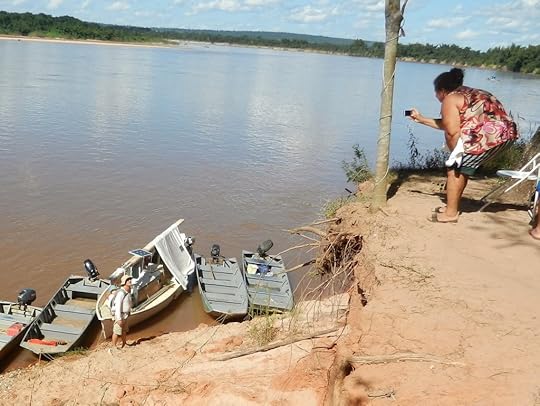
Every morning thetemperature quickly rose into the 90s and up and stayed there until lateafternoon. The only time we saw a thermometer it was 94 in the shade and 114 inthe sun. We all developed itchy heat rashes. The cockpit was okay with theawning up and the artificial breeze of the moving boat, but the cabin wasunbearable, partly because the varnished cedar of our cabin absorbed too muchheat. So, we stopped in a small town and painted the sides white (we had previouslypainted the top white). We frequently doused ourselves and George with thebailer bucket. At night, even with the fan on the cabin became too hot for allthree of us, so Steve slept curled up in the cockpit footwell, a space abouttwo feet by four feet!
Clothing was optional exceptto combat insects. By day midges caused swollen bites if we stopped at a beach.Biting flies sometimes found us on the river. Mosquito necessitated nets fromsunset to sunrise. Other insects were simply a nuisance. At night our headlampsattracted beetles and flies small enough to get through our nets and tickle ourfaces. Flying crickets swarmed the cockpit, crawled under Steve���s net, and pesteredhim. They all died during the night and required mopping up in the morning.
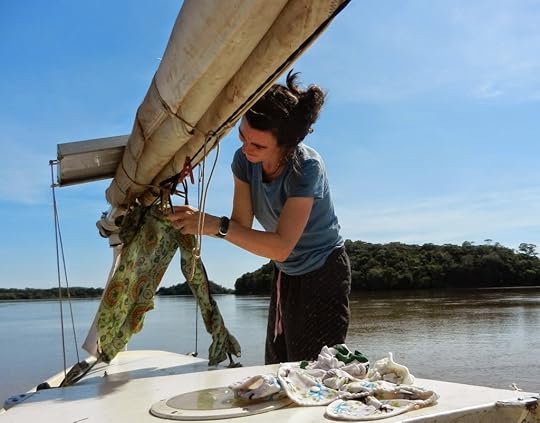
Ginny launderedincessantly. Sitting in the cockpit she stretched the articles out on deck, scrubbedthem, and rinsed them in the river. They dried lightning-fast on the linerunning from stem to stern. Steve ramped his rowing up to two hours per day,mostly in the early morning and late afternoon when the heat was less intense.He soon felt the beneficial effects in his arms and shoulders.
We saw toucans, roseatespoonbills, and tuiuius, the bigwhite stork with a red neck. Blackbirds gobbled like turkeys until they allroosted together in a tree, then they whirred like cicadas. We were happy toreacquaint with our old friends the Venezuelan Mohawk-Hairdo Chicken and theParaguayan Eagle. We call them by these names, never remembering what they arereally called. They are probably neither chickens nor eagles.
Fishermen in aluminumskiffs were a frequent sight. They were friendly, not nosy. Every couple days wepassed a town with a hotel or two which catered to them. We took theopportunity to stretch our legs. We walked a wildly grinning George between us,each holding one of his hands, until he got tired. Then we put him in thecarrier on Steve���s back. The towns were small and neat, with buildings ofstuccoed brick, painted with a darker band on the bottom. Their river-frontswere protected by walls of mortared stone, atop which plazas faced the river. Tosee the surrounding country we walked to the edge of town, where a connectingribbon or dirt or asphalt roadway receded across the limitless plain or swamp.Then we walked back to the boat, stopping for a 600-milliliter bottle of Skolor Antartica beer on the way. With any luck the bakery might have some breadrolls and the fruits and vegetable store might have some mangos or carrots.
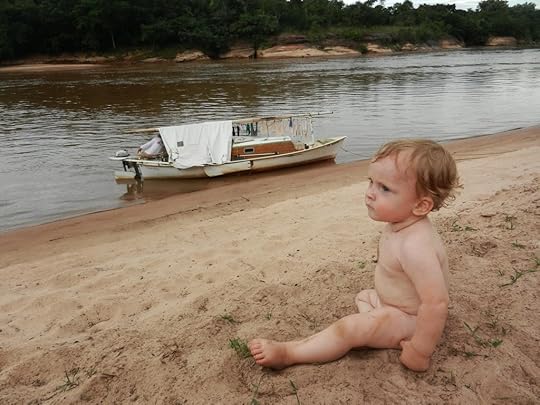
Because mosquitoescongregate around vegetation we got into a habit of getting as far as possiblefrom greenery when evening came. Sometimes we followed still channels intooffshoot lagoons and anchored out in the middle. The mosquito hour was milderthere than tied to a bank. We also slept where islands were about to immerge,tying to brush or anchoring in sand. On one such night, far from any real land,we waded in current-swept shallows as the sun set. The coarse sand had thedisconcerting tendency to give way until one was buried up to ones ankles. SuddenlySteve saw a flash of silver and felt something brush against his ankle. He hadbumped into a freshwater stingray but its spiny tail had failed to penetratehis skin. Stingray wounds are notoriously painful.
As we travelled downriverthe land got ever swampier. On our right, over the course of a week we passedIlha Bananal (Banana Tree Island), supposedly the world���s largest fluvialisland. It was more swamp than island, a vast maze of channels and lagoonsstudded with gnarly old snags. There were no signs of people on land, and fewon the river. Dark grey dolphins (apparently the same as the pink dolphins weencountered before) often followed us. Otters snorted and tumbled in the water.Alligator eyes glowed pink in the night along the marshy shore. Howler monkeys raisedtheir cacophonous din, unseen in the forest.
Ginny had probably spenta hundred hours on Google Earth building our GPS map for the Araguaia due toits countless islands and channels. Her map was reasonably accurate except thatthe imagery was shot during low water, so the river was much bigger than the mapshowed. We often navigated where it showed land. Once we got stuck in a deadend, when a strong current dissipated into brushy swamp, forcing us to motorback to the main channel. We often never knew if channels we passed were tributaryrivers or sister portions of the Araguaia, delineating islands. To build thatlevel of detail into the mapping would have required three times as much work.
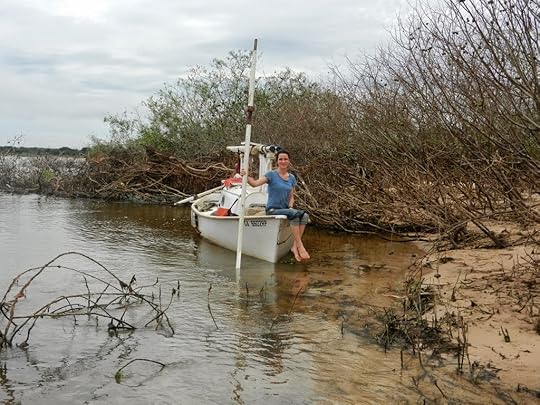
Rarely was the rivercompletely calm. Minute swirls etched its surface. Whirlpools and upsurgessuggested bottom disturbances such as rocks or sunken logs. Ripple lines markedthe downstream end of sandbars, where shallow water became deep again. If wegot to that line without running aground we would be back in deeper water. Theislands were rarely flat or of one piece. More often we saw a myriad of smallislands separated by knee-deep channels. They were studded with pools, dunes,and copses of low trees.
On April 30 we reachedS��o Felix, Mato Grosso. By Facebooking with our friend in Barra do Gar��as wefound that our second package had arrived, so we waited four days while heshipped it by bus. S��o Felix is in the land of the Caraj��s, a major indigenousgroup. Every second person on the street was Caraj��s, and the town was full ofgovernment offices catering to their needs. They generally had tattoos, thewomen with geometric bands around their calves, with men with crude circlesaround their cheekbones. We befriended a Caraj��s biologist with a spottedleopard running down his arm who told us a little about his people. Many ofthem live in small aldeias with mud and wattle houses coveredby thatched roofs. Other people are allowed to visit, but it is against the lawto take photos of anyone. In his youth they used to grow maniocand maize on the emerging islands, but now many depend on government providedfood. He also explained a little about their spiritual beliefs, how they greetthe sun when it rises, say goodbye when it sets, and how they salute the riverand other natural spirits. This biologist had once travelled to Wyoming on anexchange program to visit with the Arapaho tribe. He said he saw many similaritiesbetween them and the Caraj��s.
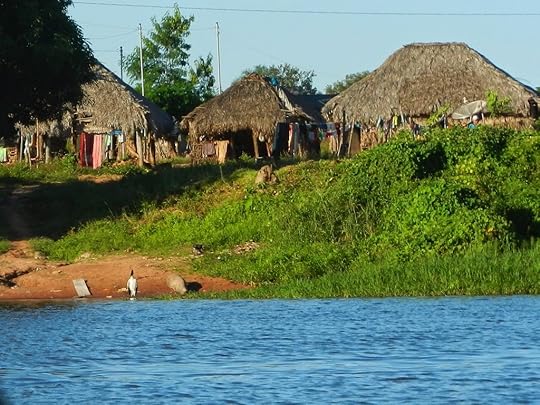
S��o Felix���s outskirts containednew subdivisions for the rural poor. They had dirt streets and tiny brickhouses. The houses often had only of one pitch of roof, but after they hadaccumulated enough building materials they built the other pitch, doubling thesize of the house. We often saw stockpiles of sand, covered with bricks toprotect them from rain, the mounds looking like graves. Crude signs advertised cottageindustries such as popsicles, fish, and culinary specialties.
Travelling downriver issuch joy! This is our third such leg, the other two being the Casiquiare/Negroand the Paraguay/Paran��. For weeks on end one drifts with the current,supplemented by such movement through the water as one cares to effectuate. Rowingis feasible and motoring can be done at slow speed, thus quietly and withlittle fuel consumption. The scenery changes quickly. We started seeinghills. The state of Tocantins now lay to right, the state of Par�� to left. Wesaw our first sea horizon: a short patch of horizon with no land, howeverbriefly, though we were still far from the sea. The river was now a mile wide.
On May 11 we reachedConceic��o (Conception), a city the size of Barra do Gar��as. The shore was linedwith planked canoes with long-tail motors. We tied up to an out-of-servicetourist boat and explored the city. A local family has adopted us, feeding usdelicious fish and cakes and showing us around town. It is a good place topause for a while.
We are happy to becruising again. It is a life full of continuity yet renewal. We are always thesame Steve, Ginny, and George in the same Thurston,yet we are always in new places. We keep things fixed, keep ourselves clothedand fed, and make progress toward our goal. We set a leisurely pace, yet we arebarely able to stay awake until 9:00, so full are our days with parenting,small-boat contortions, and the myriad labors of travel.
Some new photos may befound at: https://picasaweb.google.com/ginnygoon/BrasilPart4
Lots of love,
Steve, Ginny, &George
Published on May 14, 2014 10:45
Conceiçao do Araguaia, Mass Email

Dear friends and family,
We last emailed you from Barra do Garças, Brazil, where we awaited parts to fix our outboard motor again. We bought two cylinder/piston sets and had them sent separately via UPS in hopes of getting at least one set soon. On March 25 both packages reached São Paulo, whereupon we were instructed to go to a bank and pay import duties amounting to 100% of their value including exorbitant shipping costs. But they didn’t come anywhere near when promised, and our inquiries produced vague results.
We were holed up in a covered storage compound belonging to our friends the ice cream makers who were off travelling in their motor home. We had a room, a shower, and a refrigerator. Life was good. To fill our days we took hikes. We visited a popular hot spring, where we lounged in a series of beautifully landscaped pools, and hiked to misty waterfalls in the nearby hills.

Thurstonwas tied up to the floating restaurant down at the port. One day while getting something from the boat we noticed rat turds and chew marks! Steve looked for the culprit with no luck and we assumed he had left. When we were ready to leave it was clear he was still aboard, so we moved Thurston to a beach and shifted everything from the cabin onto the sand until there was no place left to hide. Suddenly the small rat broke cover. He scrambled about until Steve killed him with a bamboo pole. He had torn holes in our packaged food and various articles made of fabric. This would be the easiest rat to kill.
On April 8 the first cylinder and piston arrived! Overjoyed, we took them to our mechanic, Godó, a retired native of São Paulo. He had no sophisticated tools but was wonderfully wise and pleasant to work with. The cylinder had factory defects, so Steve hopped on a motorcycle taxi and took it to a machine shop, which installed missing threads. Finally we got the motor back together. Neither Godó nor the machinist accepted any money for their services.
We moved aboard back Thurston, re-immersing ourselves in life at the port, where grandstand-like steps marched down into the water. By day people sat looking out over the macho jet-skiers who zoomed back and forth, turning on a dime and shooting up maelstroms of foam. One guy specialized in riding backwards. Another guy acted like a matador. While spinning his machine he stood with both feet on the floorboard to the inside of the spin, one hand on the throttle, the other arm waving gracefully in the air as if he were waving a flag at a bull. The jet skiers stayed in front of the steps as if they were a grandstand. It was purely a spectator sport.
That was the daytime. By night the port rocked with folk music and happy partiers. In the morning municipal workers picked up the garbage and woke up the drunks still asleep on the steps.

The motor required further debugging due to a leaky oil seal and a dirty carburetor. The rats kept coming and the stove and backup stove were nearly out of commission. We were beginning to feel like Barra do Garças was against us! However, it would be weeks before we reached a town as large as Barra, so we had to be sure everything was in order. Five trips to the mechanic, two aborted attempts to leave and two more increasingly clever rats later brought us to April 12. Though leery of our cursed Honda, we cast off! We kept the motor barely above idle to break it in gently. We were eager to get some kilometers under our keel because the rapids two-thirds of the way to Belem would get worse as the dry season progressed, lowering the river level and exposing rocks.
The tall hills soon melted away, leaving only low, green banks. Almost nobody lived along the river, nor was there any farming. If we managed to squeeze past the matted riverine brush we found vast expanses of twisted trees, tall grass, and palm shrubs with thorns like six-inch needles. We settled into travel routines, waking at day break as George crawled over us. Steve made breakfast in the cockpit, then rowed after if it wasn’t yet too hot. Motored through lunch, George splashing in the cockpit off and on all day as we dumped water on him. An afternoon break to explore a beach, town or bank, late afternoon row, then a sunset stop in the least buggy place we could find. George played in the cockpit with Steve reading “As Viajens do Gulliver” (Gulliver’s Travels) over and over and over again, while Ginny prepared dinner. Steve operated the stove while Ginny and George read “As Viajens do Gulliver” over and over and over again in the cabin. Eat, clean up, pass out. A simple life can be quite exhausting!
The river, initially around 500 meters wide, spread more and more with the addition of new tributaries. Because these were relatively clear, the soupy-orange Araguaia became clearer until visibility reached one foot. At first we ran onto sandbars and had to pull ourselves off. But perhaps the tributaries were at a higher stage than the Araguaia because as we proceeded north the banks got fuller, the sandbars fewer.

Every morning the temperature quickly rose into the 90s and up and stayed there until late afternoon. The only time we saw a thermometer it was 94 in the shade and 114 in the sun. We all developed itchy heat rashes. The cockpit was okay with the awning up and the artificial breeze of the moving boat, but the cabin was unbearable, partly because the varnished cedar of our cabin absorbed too much heat. So, we stopped in a small town and painted the sides white (we had previously painted the top white). We frequently doused ourselves and George with the bailer bucket. At night, even with the fan on the cabin became too hot for all three of us, so Steve slept curled up in the cockpit footwell, a space about two feet by four feet!
Clothing was optional except to combat insects. By day midges caused swollen bites if we stopped at a beach. Biting flies sometimes found us on the river. Mosquito necessitated nets from sunset to sunrise. Other insects were simply a nuisance. At night our headlamps attracted beetles and flies small enough to get through our nets and tickle our faces. Flying crickets swarmed the cockpit, crawled under Steve’s net, and pestered him. They all died during the night and required mopping up in the morning.

Ginny laundered incessantly. Sitting in the cockpit she stretched the articles out on deck, scrubbed them, and rinsed them in the river. They dried lightning-fast on the line running from stem to stern. Steve ramped his rowing up to two hours per day, mostly in the early morning and late afternoon when the heat was less intense. He soon felt the beneficial effects in his arms and shoulders.
We saw toucans, roseate spoonbills, and tuiuius, the big white stork with a red neck. Blackbirds gobbled like turkeys until they all roosted together in a tree, then they whirred like cicadas. We were happy to reacquaint with our old friends the Venezuelan Mohawk-Hairdo Chicken and the Paraguayan Eagle. We call them by these names, never remembering what they are really called. They are probably neither chickens nor eagles.
Fishermen in aluminum skiffs were a frequent sight. They were friendly, not nosy. Every couple days we passed a town with a hotel or two which catered to them. We took the opportunity to stretch our legs. We walked a wildly grinning George between us, each holding one of his hands, until he got tired. Then we put him in the carrier on Steve’s back. The towns were small and neat, with buildings of stuccoed brick, painted with a darker band on the bottom. Their river-fronts were protected by walls of mortared stone, atop which plazas faced the river. To see the surrounding country we walked to the edge of town, where a connecting ribbon or dirt or asphalt roadway receded across the limitless plain or swamp. Then we walked back to the boat, stopping for a 600-milliliter bottle of Skol or Antartica beer on the way. With any luck the bakery might have some bread rolls and the fruits and vegetable store might have some mangos or carrots.

Because mosquitoes congregate around vegetation we got into a habit of getting as far as possible from greenery when evening came. Sometimes we followed still channels into offshoot lagoons and anchored out in the middle. The mosquito hour was milder there than tied to a bank. We also slept where islands were about to immerge, tying to brush or anchoring in sand. On one such night, far from any real land, we waded in current-swept shallows as the sun set. The coarse sand had the disconcerting tendency to give way until one was buried up to ones ankles. Suddenly Steve saw a flash of silver and felt something brush against his ankle. He had bumped into a freshwater stingray but its spiny tail had failed to penetrate his skin. Stingray wounds are notoriously painful.
As we travelled downriver the land got ever swampier. On our right, over the course of a week we passed Ilha Bananal (Banana Tree Island), supposedly the world’s largest fluvial island. It was more swamp than island, a vast maze of channels and lagoons studded with gnarly old snags. There were no signs of people on land, and few on the river. Dark grey dolphins (apparently the same as the pink dolphins we encountered before) often followed us. Otters snorted and tumbled in the water. Alligator eyes glowed pink in the night along the marshy shore. Howler monkeys raised their cacophonous din, unseen in the forest.
Ginny had probably spent a hundred hours on Google Earth building our GPS map for the Araguaia due to its countless islands and channels. Her map was reasonably accurate except that the imagery was shot during low water, so the river was much bigger than the map showed. We often navigated where it showed land. Once we got stuck in a dead end, when a strong current dissipated into brushy swamp, forcing us to motor back to the main channel. We often never knew if channels we passed were tributary rivers or sister portions of the Araguaia, delineating islands. To build that level of detail into the mapping would have required three times as much work.

Rarely was the river completely calm. Minute swirls etched its surface. Whirlpools and upsurges suggested bottom disturbances such as rocks or sunken logs. Ripple lines marked the downstream end of sandbars, where shallow water became deep again. If we got to that line without running aground we would be back in deeper water. The islands were rarely flat or of one piece. More often we saw a myriad of small islands separated by knee-deep channels. They were studded with pools, dunes, and copses of low trees.
On April 30 we reached São Felix, Mato Grosso. By Facebooking with our friend in Barra do Garças we found that our second package had arrived, so we waited four days while he shipped it by bus. São Felix is in the land of the Carajás, a major indigenous group. Every second person on the street was Carajás, and the town was full of government offices catering to their needs. They generally had tattoos, the women with geometric bands around their calves, with men with crude circles around their cheekbones. We befriended a Carajás biologist with a spotted leopard running down his arm who told us a little about his people. Many of them live in small aldeias with mud and wattle houses covered by thatched roofs. Other people are allowed to visit, but it is against the law to take photos of anyone. In his youth they used to grow manioc and maize on the emerging islands, but now many depend on government provided food. He also explained a little about their spiritual beliefs, how they greet the sun when it rises, say goodbye when it sets, and how they salute the river and other natural spirits. This biologist had once travelled to Wyoming on an exchange program to visit with the Arapaho tribe. He said he saw many similarities between them and the Carajás.

São Felix’s outskirts contained new subdivisions for the rural poor. They had dirt streets and tiny brick houses. The houses often had only of one pitch of roof, but after they had accumulated enough building materials they built the other pitch, doubling the size of the house. We often saw stockpiles of sand, covered with bricks to protect them from rain, the mounds looking like graves. Crude signs advertised cottage industries such as popsicles, fish, and culinary specialties.
Travelling downriver is such joy! This is our third such leg, the other two being the Casiquiare/Negro and the Paraguay/Paraná. For weeks on end one drifts with the current, supplemented by such movement through the water as one cares to effectuate. Rowing is feasible and motoring can be done at slow speed, thus quietly and with little fuel consumption. The scenery changes quickly. We started seeing hills. The state of Tocantins now lay to right, the state of Pará to left. We saw our first sea horizon: a short patch of horizon with no land, however briefly, though we were still far from the sea. The river was now a mile wide.
On May 11 we reached Conceicão (Conception), a city the size of Barra do Garças. The shore was lined with planked canoes with long-tail motors. We tied up to an out-of-service tourist boat and explored the city. A local family has adopted us, feeding us delicious fish and cakes and showing us around town. It is a good place to pause for a while.
We are happy to be cruising again. It is a life full of continuity yet renewal. We are always the same Steve, Ginny, and George in the same Thurston, yet we are always in new places. We keep things fixed, keep ourselves clothed and fed, and make progress toward our goal. We set a leisurely pace, yet we are barely able to stay awake until 9:00, so full are our days with parenting, small-boat contortions, and the myriad labors of travel.
Some new photos may be found at: https://picasaweb.google.com/ginnygoon/BrasilPart4
Lots of love,
Steve, Ginny, & George
Published on May 14, 2014 10:45
March 28, 2014
Barra do Gar��as, Mato Grosso
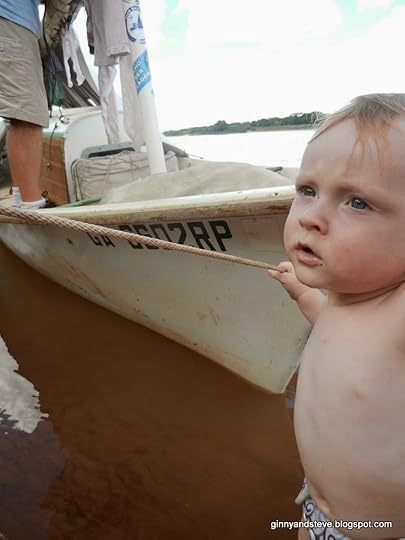 Dearfriends and family,
Dearfriends and family,We last emailed you from Larry andKaren���s near Atlanta. On February 26th we took an overnight flightto Brasilia, then a half hour flight back to Goiania in Central Brazil. There westayed with Felipe and Waleska, our Couch Surfing friends from before. After ashort visit with them we caught a series of buses to Maurilandia, where ourboat was waiting for us at a friend���s chacara(small farm) on the Rio Verdao.

It now being the rainy season thisfarming town���s dust had turned to mud. Our friends, Aldin and Kelly and their19-year-old daughter Karen, kindly put us up in the master bedroom andbombarded us with delicious Brazilian food during our first week in Brazil.Right away we patched a hole in the bottom of Thurston and installed a new motor mount that will allow us toadjust the height of the motor. With these things completed we resumed oursearch for the 200-mile transport to the Araguaia River. This would be ourlongest and most expensive portage yet.
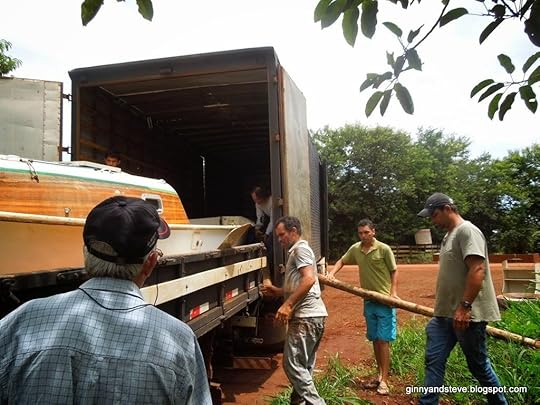
We wandered around introducingourselves to truck drivers until we met Marcus, the owner of a produce storeand three trucks of varied sizes for moving his fruits and vegetables. Hefinally agreed to transport us for $500 in his largest truck, which is like amoving van in that it has a tall box in back. With a lot of hard work, five menand three boys got Thurston up insideand closed the doors.
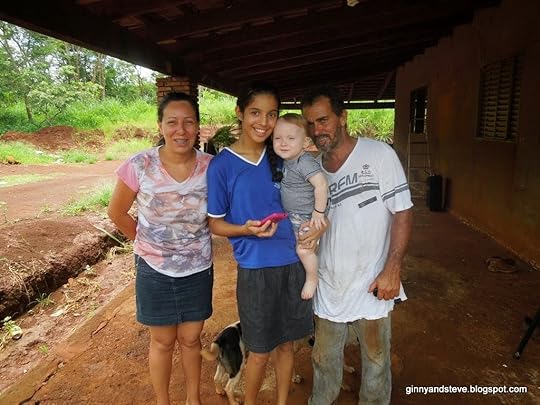
It was the early afternoon when wesaid our farewells to our Maurilandia friends, Aldin, Kelly, Karen, Diego, andDouglas. Karen promised to visit the US when she���s older. Kelly asked that weleave Georgie behind. We hope that by denying the latter request Kelly andAldin will have a reason to come visit us too!
As we drove northwest the landchanged from a rolling plain covered in soybeans, corn and sugar cane to hillyuplands with picturesque escarpments and valley floors studded with palm trees.We crossed the divide into the Amazon basin and descended to three adjoining townswhere the Araguaia and Gar��asrivers join. One lies on the east side of the Araguaia, one lies on the westside of the Gar��as, and the third lies on the tapering peninsula between the two. Thelargest is the western-most city, Barra do Gar��as, which means Mouth of the River ofStorks.
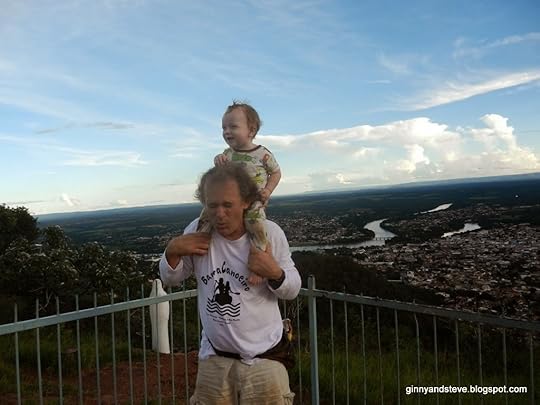
In crossing the Rio Araguaia wepassed from the state of Goias to that of Mato Grosso. Like in the U.S.,Brazil���s states get steadily bigger and wilder as one proceeds west from theAtlantic. Mato Grosso is all the way at the west edge of the country. We had travelledalong its western margin, opposite Bolivia, when we ascended the Guapore anddescended the Paraguay. Now we would descend a river dividing it from Goias.
We arrived at the Barra do Gar��as boatramp at nightfall. It had a good grade and good pavement yet Marcus wasreluctant to back down it. He checked his brakes by having Steve pump the pedalwhile he checked the escapement of air at various locations. Then he actedimpetuously. He backed down until his rear wheels were underwater and the floorof the box was at river level, then shut off his engine. We were relieved thatwe could simply push Thurston intothe river. But suddenly Marcus started pumping the brake and yelling for someoneto chock his wheels. We hustledout, Ginny with George in her arms, but before we could run ten paces in searchof a rock or log the truck had rolled backward into the river! The water pushingagainst the box quickly rotated the truck ninety degrees, leaving it parallelto shore, facing upriver. It rolled backward until it came up against anunderwater obstacle, then came to rest thirty feet from shore with the driver���sside tilting downward toward the deeper water further out. The cab was almostentirely underwater, the box half-submerged. Marcus swam out from an openwindow. There was no telling how long the truck would stay where it was.
Ginny watched with mixed horrorand awe as Steve jumped in the river and swam to the back doors. The currentwas swift, the water turbid, reddish brown. The current gushed violently aroundthe truck but left a calm eddy at the back. Opening the double doors he found Thurston afloat inside. The masts andbooms were also afloat. He closed himself in the truck and ordered the floatingobjects. Then to Ginny���s great relief he emerged, swimming Thurston out, much as one would lead a horse from a burning barn.Someone tied the boat to a concrete post while Steve returned to the truck forthe spars, which he pushed to people on the tall concrete steps that lined the shore.
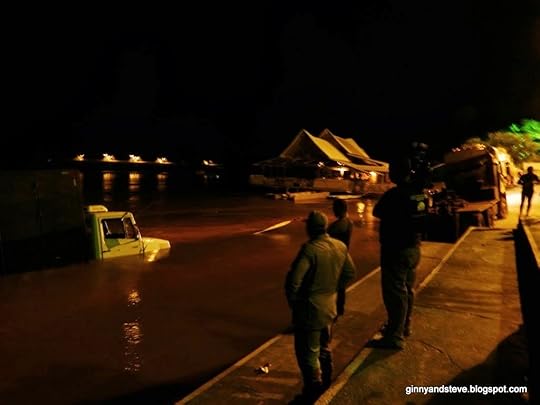
Ginny���s daypack and Steve���sshoulder bag were still in the cab. Steve found them floating inside andretrieved them through a window. They contained a camera, a Sony Walkman, and aKindle, all ruined, also our passports and other vital documents, which would requirecareful drying. The leeboards and the heavy aluminum floorboards were still inthe box. The rest of our equipment had been stowed in Thurston and was therefore safe. Ginny paced impotently and sworein disbelief while facilitating people who wanted to coo at George. Then she madeup a bed for him in the boat and put him to sleep amidst the chaos.
Soldiers, firemen, newsmedia (see: An article here ) and a crowd numbering in the hundredsquickly gathered. A pair of scuba divers suited up. Due to the hazardouscurrent they worked with agonizing slowness, but eventually they attached onecable to the front of the truck and another to the side facing shore. Then two massivetow trucks slowly winched these respective cables in.
By 2:00 a.m. the truck was back ondry land and the crowd had dispersed. Steve retrieved the remaining gear andpaid Marcus his money. Apparently he had lost control because the hand brakedidn���t work, the air leaked out of the road brakes, and the transmission got stuckin neutral. Normally breezy and boastful, he was a sad sight. ���My mouth is drywith shame,��� he said as he left with the tow-truck drivers. The towing andrepair bills would be huge and he had no insurance.
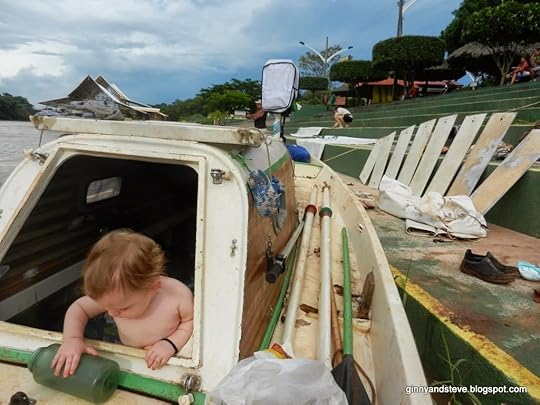
The next day we beganrecuperating. Ginny dried the passports while Steve filled our water and fueltanks. We quickly made friends, attended an excellent barbeque, and got shown around. The towns downstream being smallerand further apart, we bought provisions. Then we motored a bit upstream to verifythat the motor was functioning properly. It wasn���t. First it wouldn���t run exceptwith the carburetor fully choked, then the clutch slipped intermittently.
We returned to the port, which isfrequented by jet skis and light pleasure boats. There are no large watercraft.The upland consists of small parks and outdoor bar/restaurants. There is also afloating restaurant upstream of the boat ramp. We moored Thurston at the downstream edge of the port, her hull nudging againsta sandy bank overgrown with tall grass. At night musicians performed folkballads in the parks and restaurants. They played guitar and sang with greatskill.
One of our new friends, DoctorChu-en-lay, took Steve and the motor to a mechanic on the other side of theriver. This fellow, a retired specialist in outboards, helped Steve replace thebottom oil seal. But in the next trial the motor ran rough and oil gushed out throughthe crankcase vent.

This time Steve and the kindlymechanic opened the motor all the way to its single piston. The clip holdingone end of the wrist pin had come loose. The pin had drifted into contact withthe cylinder skirt and eroded a groove, lowering compression and causing thepiston to pressurize the crankcase, hence the escaping oil. We needed a newcylinder and piston, which we didn���t have. We had replaced them in Uruguay anddidn���t think it would be necessary again so soon.
After sleeping on it we decided tobuy the parts on the internet, have them shipped to ultra-dependable Larry, andhave him ship them to us. To double our odds of getting the parts quicklythrough customs, and to end up with a spare set, we bought two cylinders andtwo pistons. Larry shipped the two sets independently, to different addresses, offriends on either side of the state line. One of the shipments also included anew camera and other items. The shipping and import duties will be horriblyexpensive but we want to leave as soon as possible, before the river drops tothe point where exposed sand bars and rocks hamper navigation.
We are putting our delay here touse. We have George-proofed Thurston,improved storage arrangements, repaired our awning, and mended our mosquito andno-see-um nets. Barra do Gar��as is home to Parque National do Serra Azul, which is atreasure-trove of trails and waterfalls! A steep mountain in the park with astatue of Christ on top overlooks the town. We have hiked up there ascending theinfamous 1220 step staircase and back down via a chain of 8 waterfalls that followa cleft in the mountain.
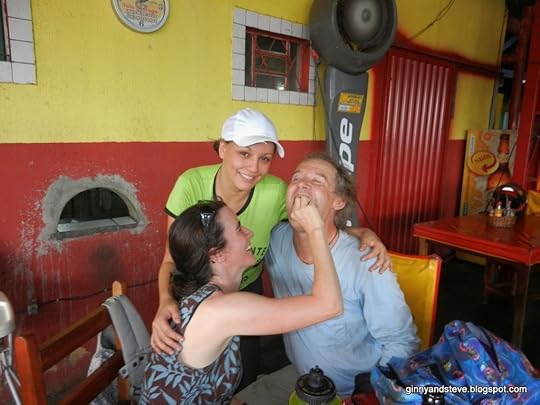
We are getting to know Barra andits little sister cities. One day while we were lunching in a restaurant Stevetried what looked like a stewed potato. It didn���t give way as he expected so hebit harder. Suddenly his teeth broke into a soft interior and dozens of tinyspines became lodged in his tongue and the walls of his mouth! Concernedemployees explained that it was a fruit called pequi and you are only supposed to eat the outer flesh. Theyassumed we knew, because who doesn���t? In fact we had been told of it back inMaurilandia, but thought it would be something fruitier and less potato-like! Ginnylabored an hour removing most of the spines with tweezers. A dental surgeon gotthe last few.

The days are hot but the nightsare bearable. Rainstorms hit every couple days. The river has gone up and down,mostly down since the rainy season is tapering off. On March 19 we celebratedGeorge���s first birthday party with new friends in Kiosque do Lazaro, a bar/restaurantdirectly above Thurston. Lazarohimself brought a giant cake which George relished. He and everything within athree-foot radius quickly became covered with white frosting to the amusementof all. Georgie enjoyed the attention. An unexpected birthday surprise came inthe form of Marcus who was back in town with a new engine for the truck.
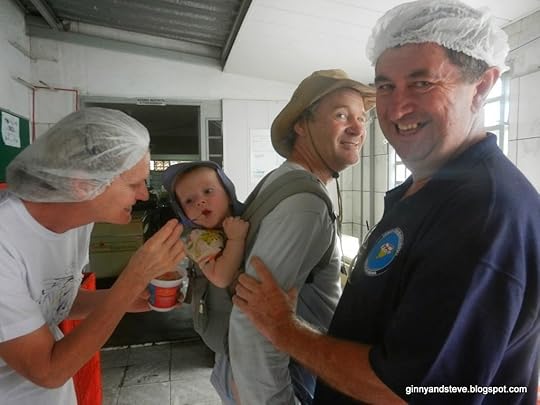
Now that George crawls and getsinto everything the boat seems smaller than ever. One of us must constantlymonitor him. To ease our stay here Heltor and Mari, who run the local ice creamfactory Sorvetes Heytto, have installed us in a spare room inside their walled compounddowntown. When the motor is fixed we will begin our descent of the Rio Araguaiato the city of Belem at the mouth at the Amazon. This will take months, so vastare the distances.
For those of you wondering how Georgeis adjusting to being back in his native land here���s a little glimpse of theaverage day in the life of George. He wakes us up around 6:30 am jabbering andcrawling all over us with a big droolly grin. He plays what are to himhilarious games with his dad awhile, then paws through the fruit and veggiedepartment taking a bite out of each item he finds. We share our breakfast withhim and he smashes it around his face and our clothes. The morning is toppedoff with a map of the constellations made of cookie crumbs, then a nap. A nicebath when he wakes up then he wants to go out and crawl around.
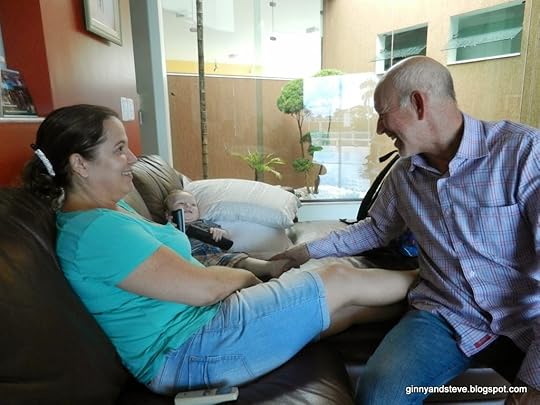 We take himup to the park and he maneuvers among the palapas, collecting dirt and lookingfor old or new friends. When he sees someone smiling at him he stretches outhis arm to them, ���Ooooh!���. They come over or he crawls to them, then begins ascene of mutual cooing which can extend infinitely as George works his way fromone set of arms to the next. We are invited to lunch with new friends, Georgetaking over their home and pets. When it cools off we go for a walk, George inhis carrier. He is well known in this town and people often stop us to talk tohim. Sometimes they talk to us too. As 8pm approaches he turns up the squirmsand we have to get him to bed. On a good day he���ll conk out, limbs spread totake up as much room as possible. When we crawl into bed a couple of peacefulhours later we have to settle for the tiny gaps of bed he has left us, butwe���re usually so exhausted by then we hardly notice. In short, George is aboutas happy as a baby could be, which it turns out is pretty damn happy.
We take himup to the park and he maneuvers among the palapas, collecting dirt and lookingfor old or new friends. When he sees someone smiling at him he stretches outhis arm to them, ���Ooooh!���. They come over or he crawls to them, then begins ascene of mutual cooing which can extend infinitely as George works his way fromone set of arms to the next. We are invited to lunch with new friends, Georgetaking over their home and pets. When it cools off we go for a walk, George inhis carrier. He is well known in this town and people often stop us to talk tohim. Sometimes they talk to us too. As 8pm approaches he turns up the squirmsand we have to get him to bed. On a good day he���ll conk out, limbs spread totake up as much room as possible. When we crawl into bed a couple of peacefulhours later we have to settle for the tiny gaps of bed he has left us, butwe���re usually so exhausted by then we hardly notice. In short, George is aboutas happy as a baby could be, which it turns out is pretty damn happy.And a final George note, he nowhas a college fund, so if anyone wants to make a donation for his birthdayplease contact us and we���ll tell you how.
More new photos may be found at: https://picasaweb.google.com/ginnygoon/BrasilPart4
Lots of love,Steve, Ginny, & George
Published on March 28, 2014 14:14

